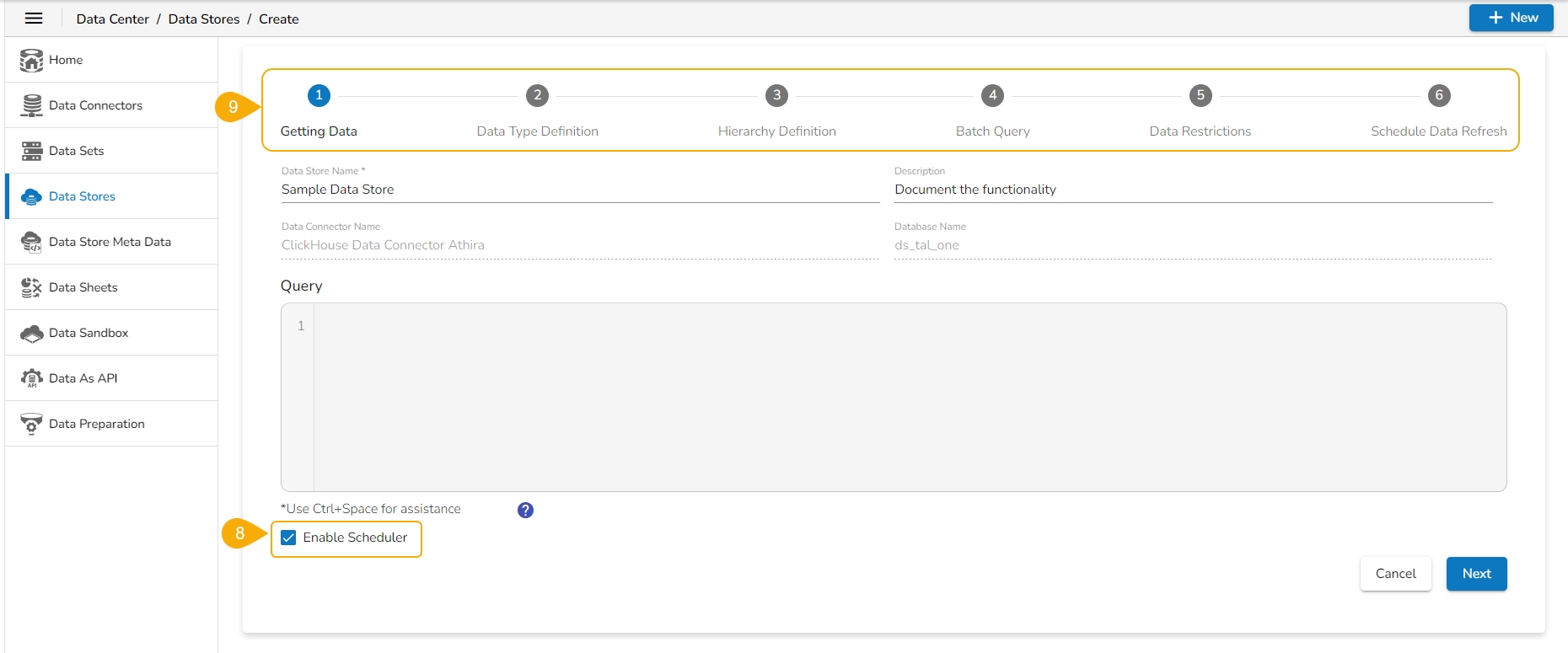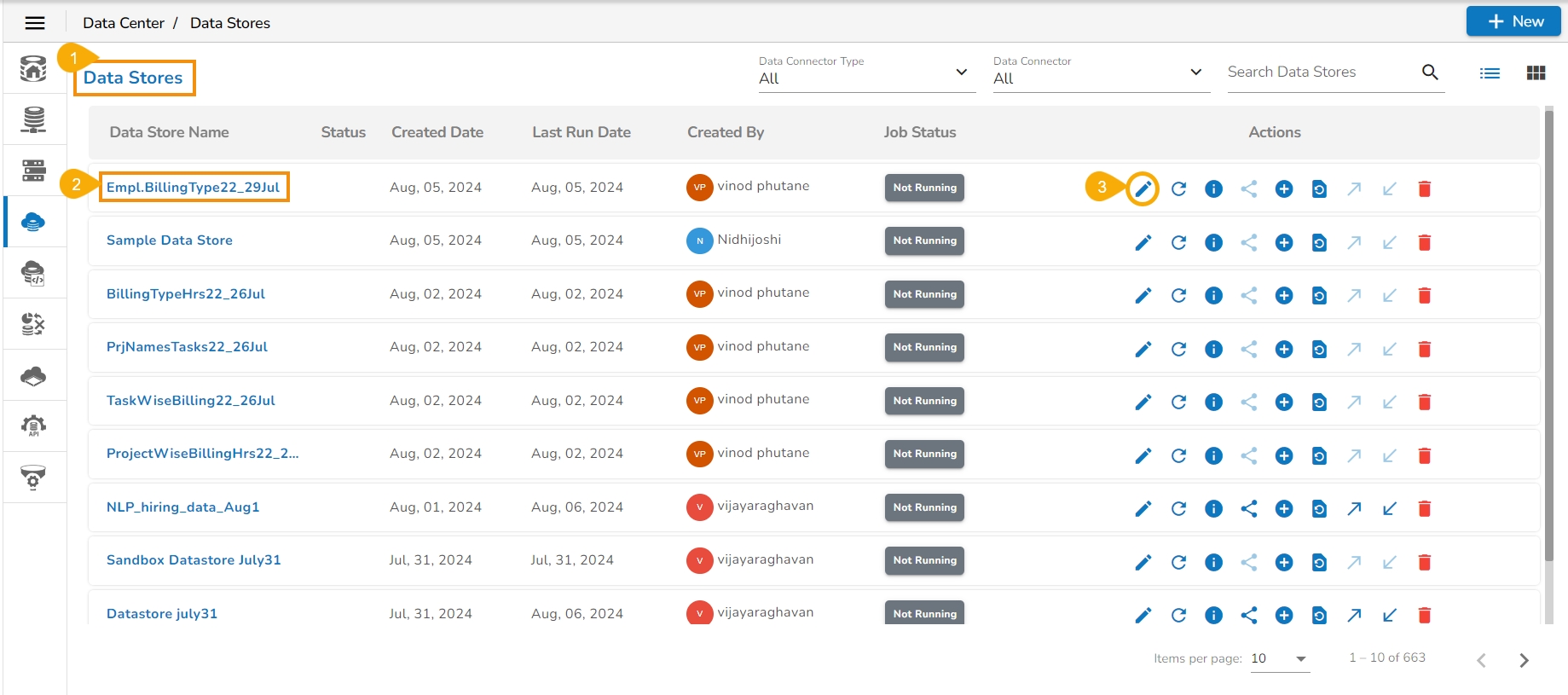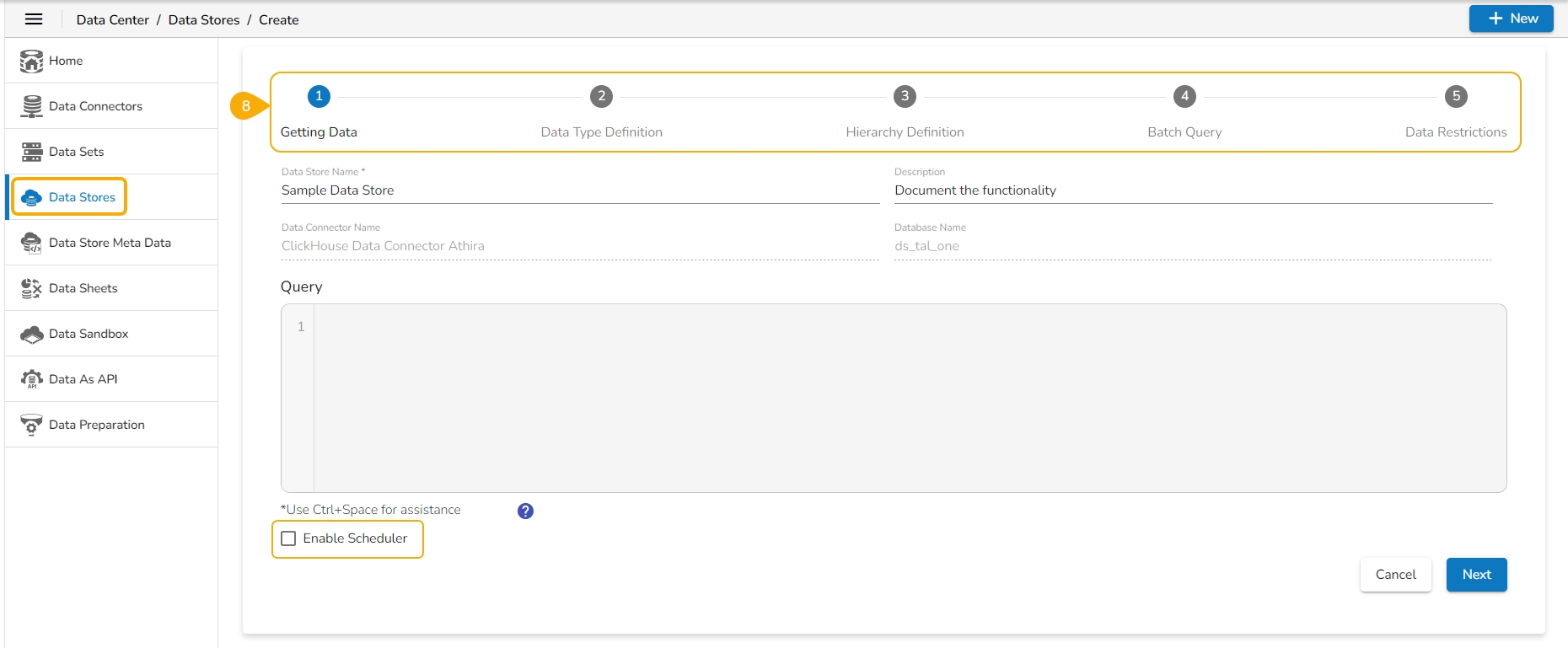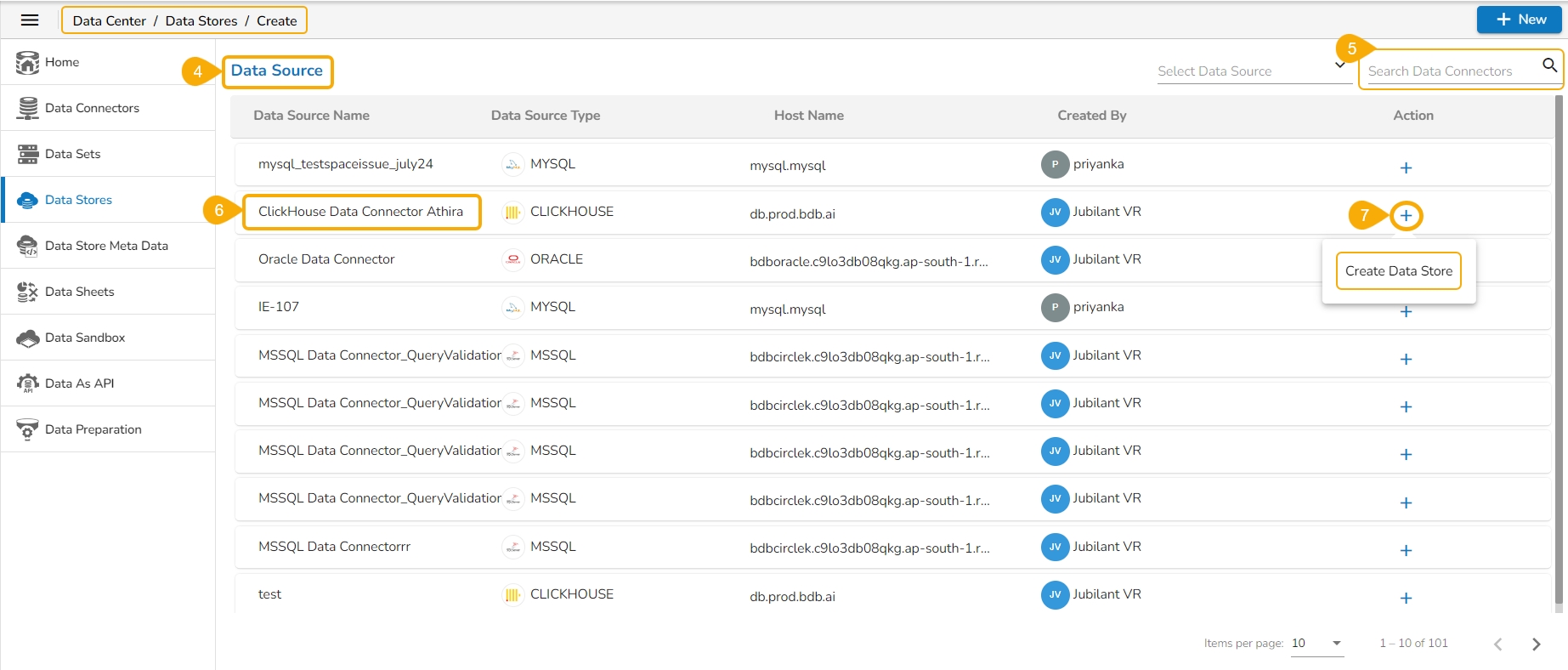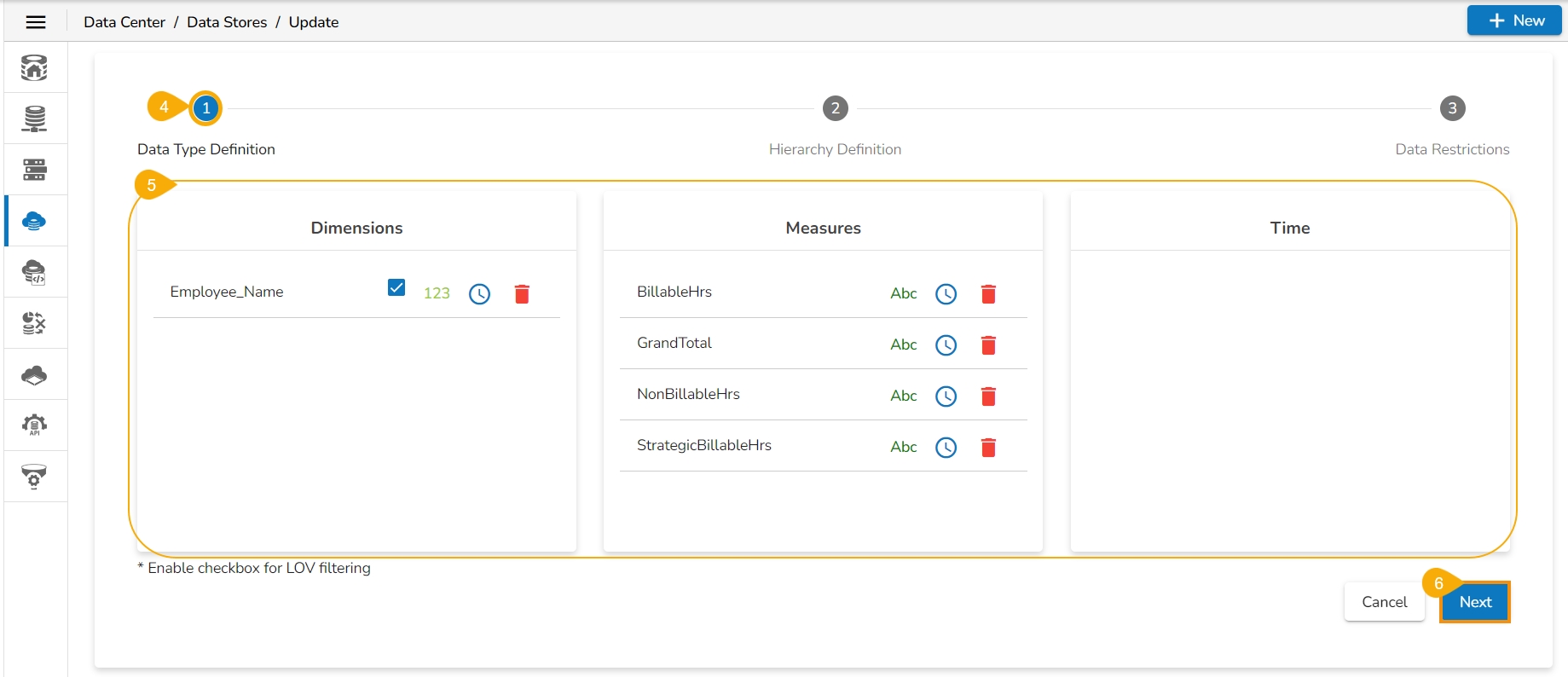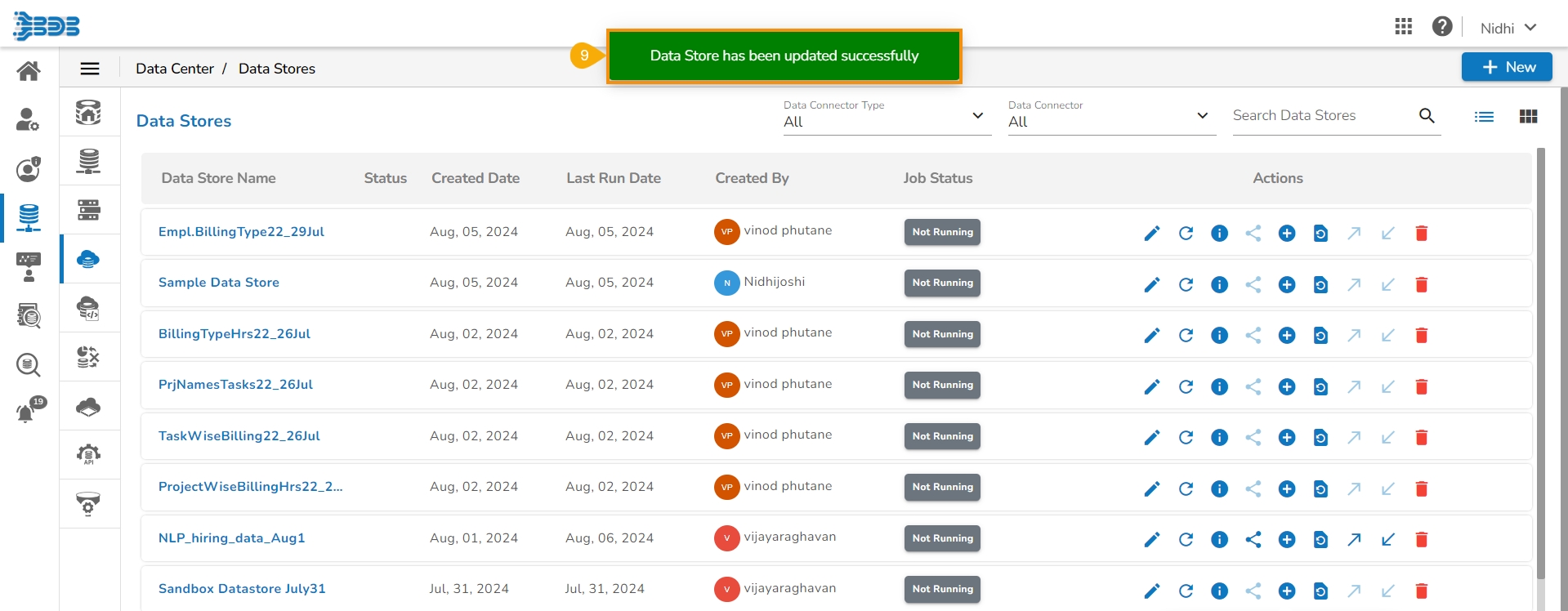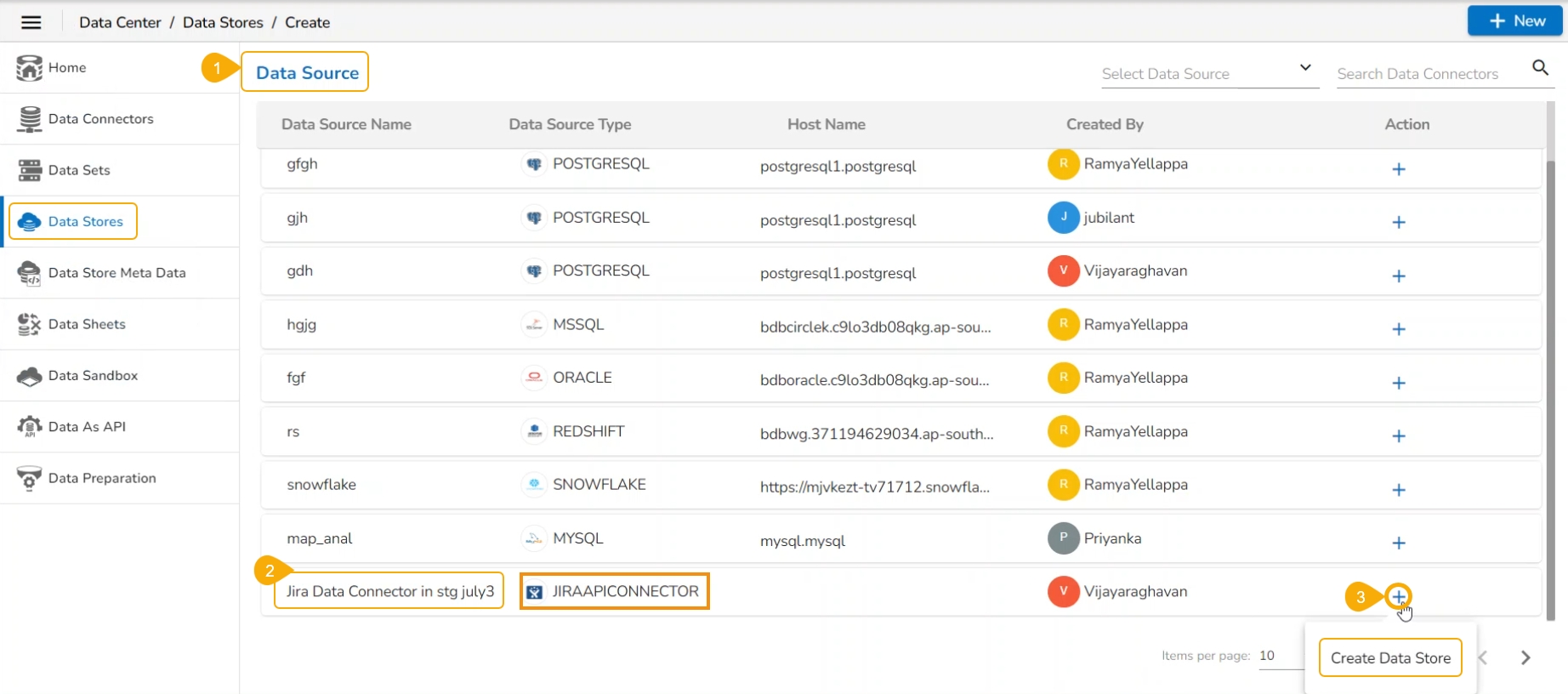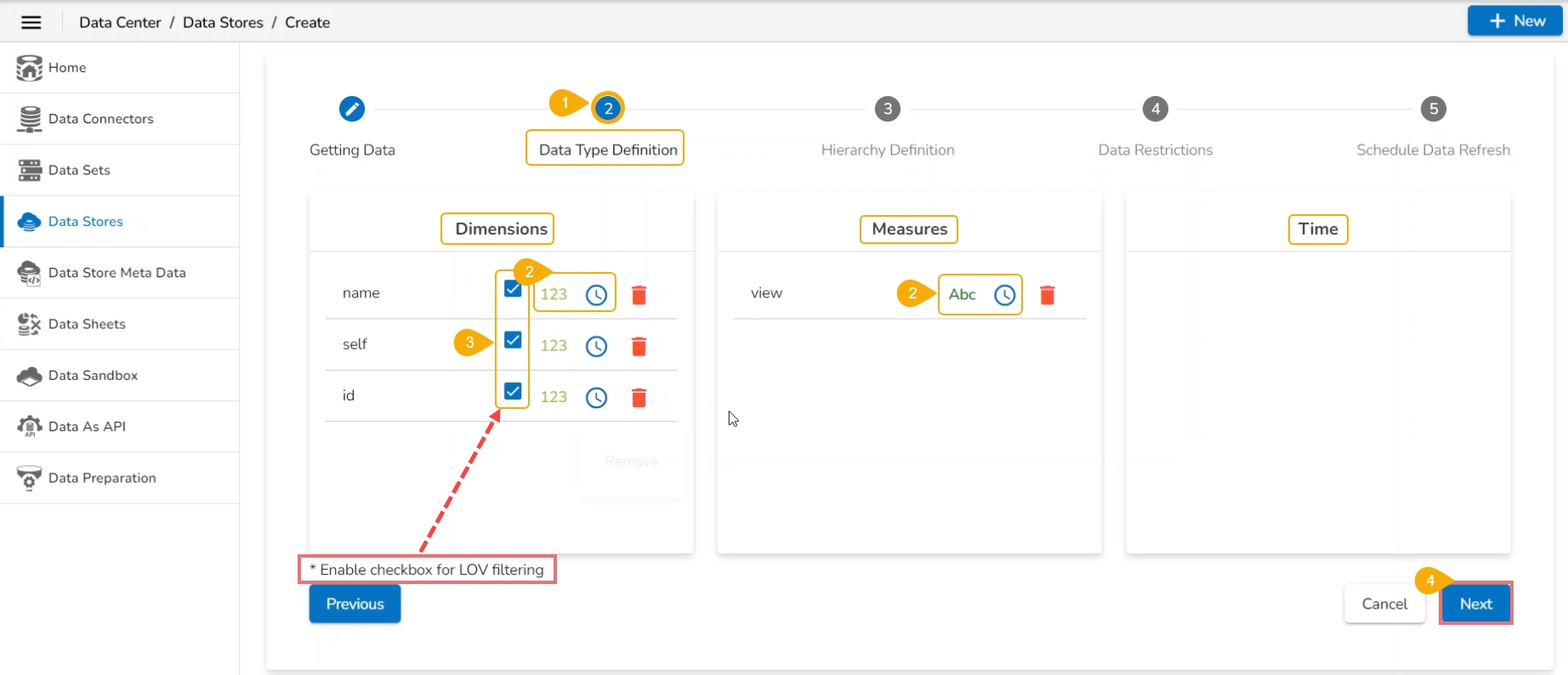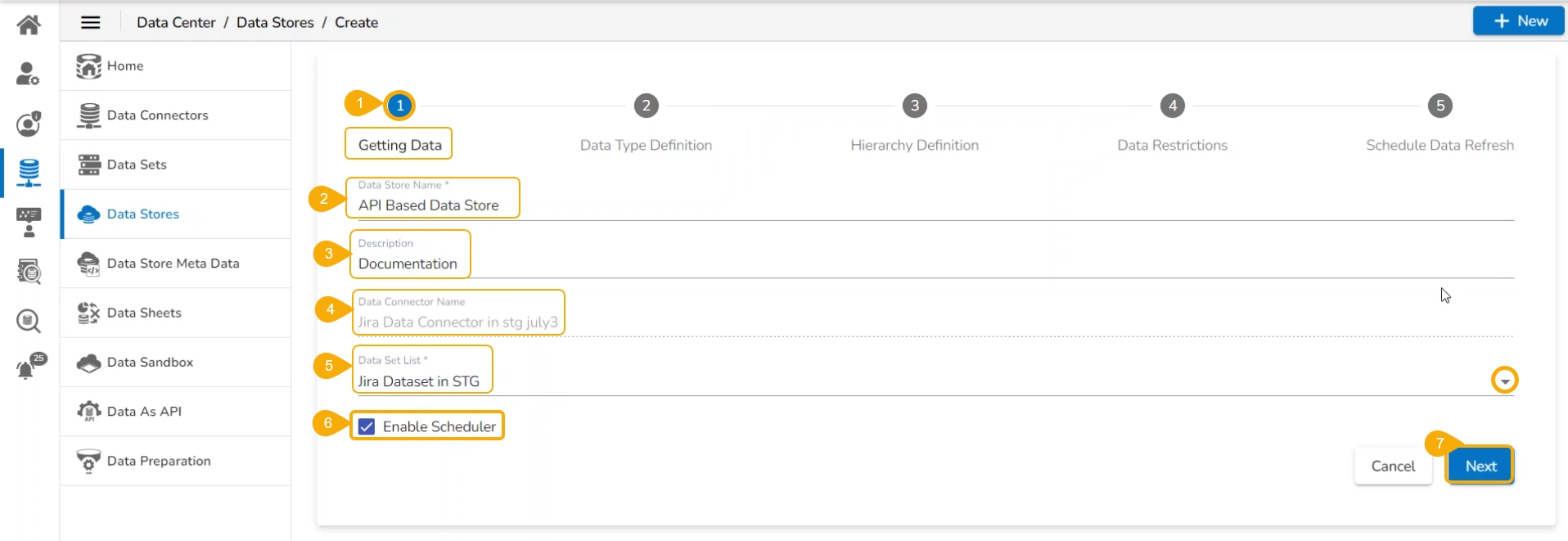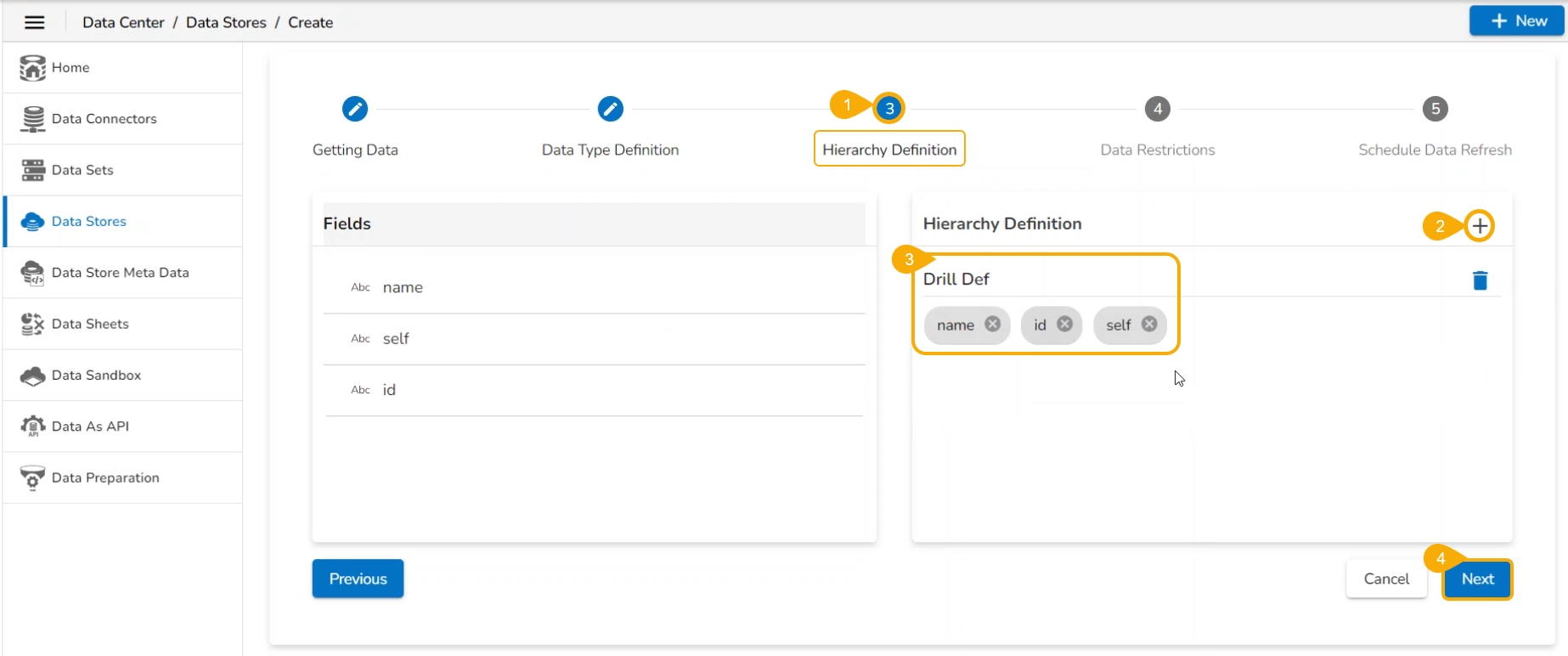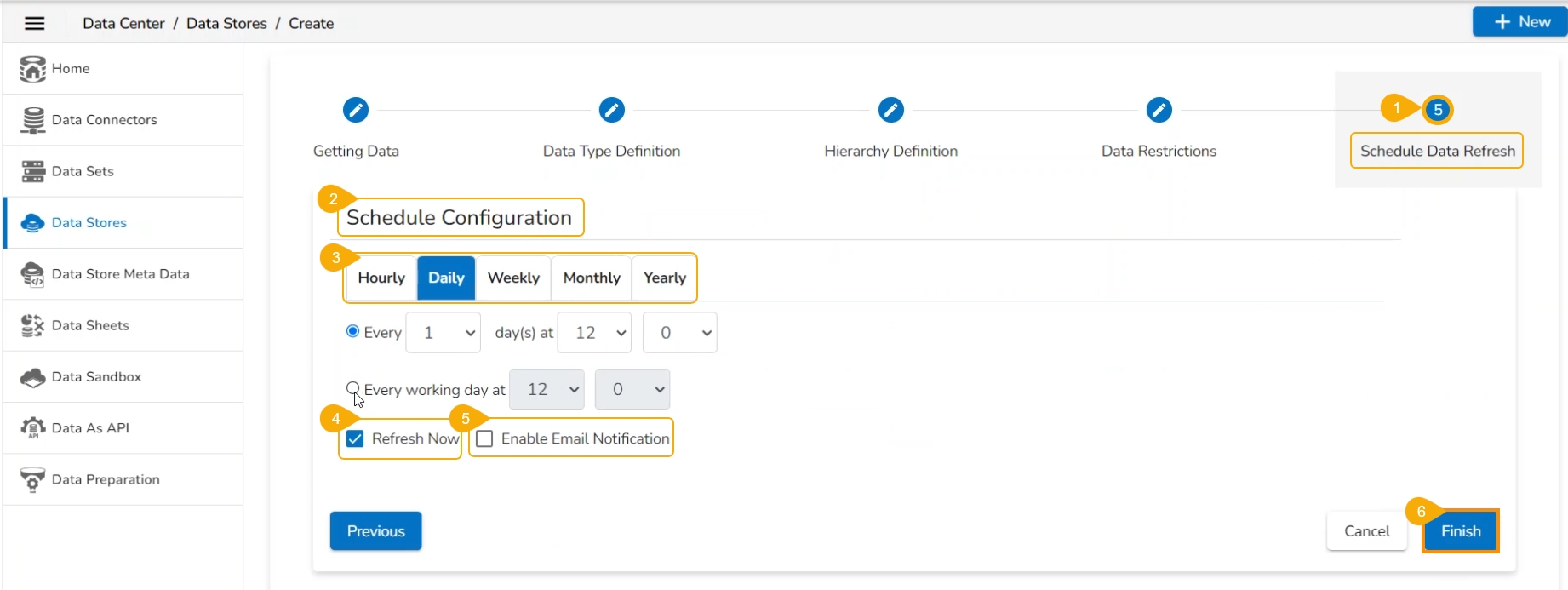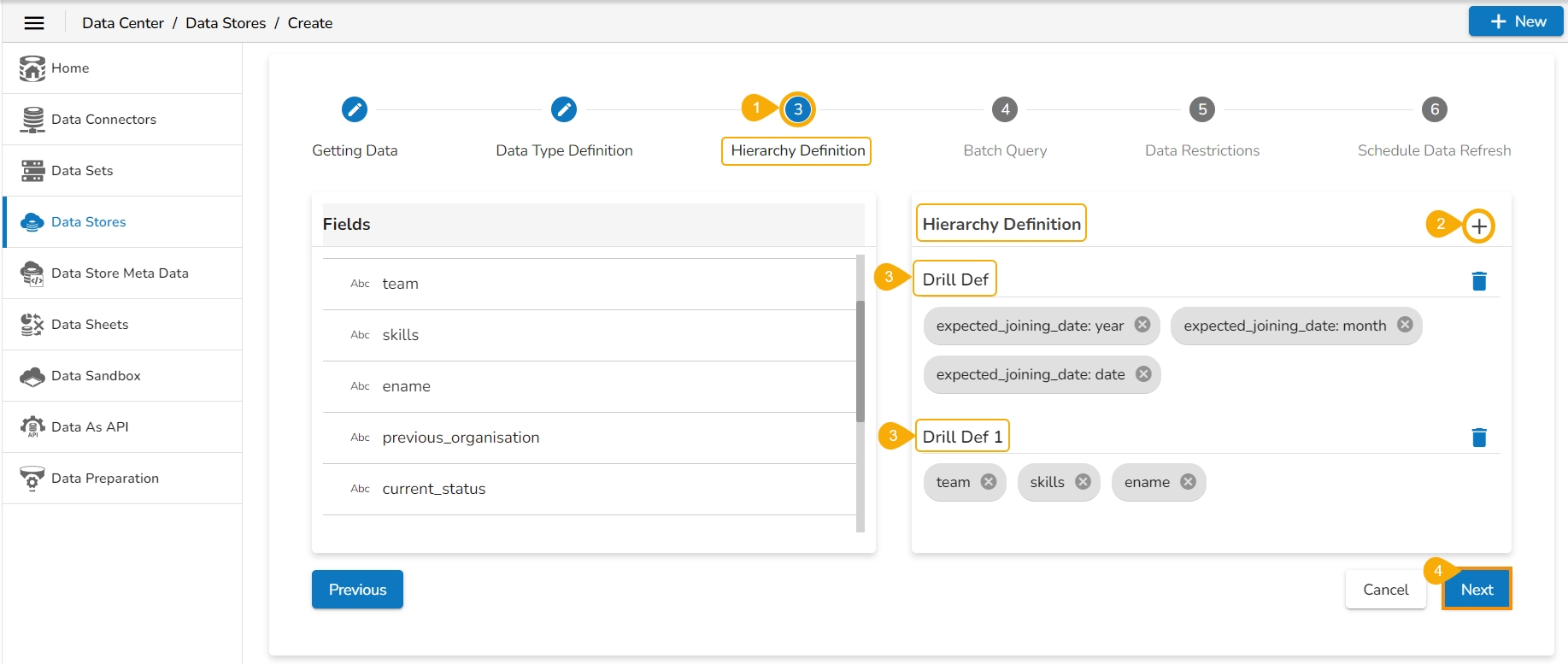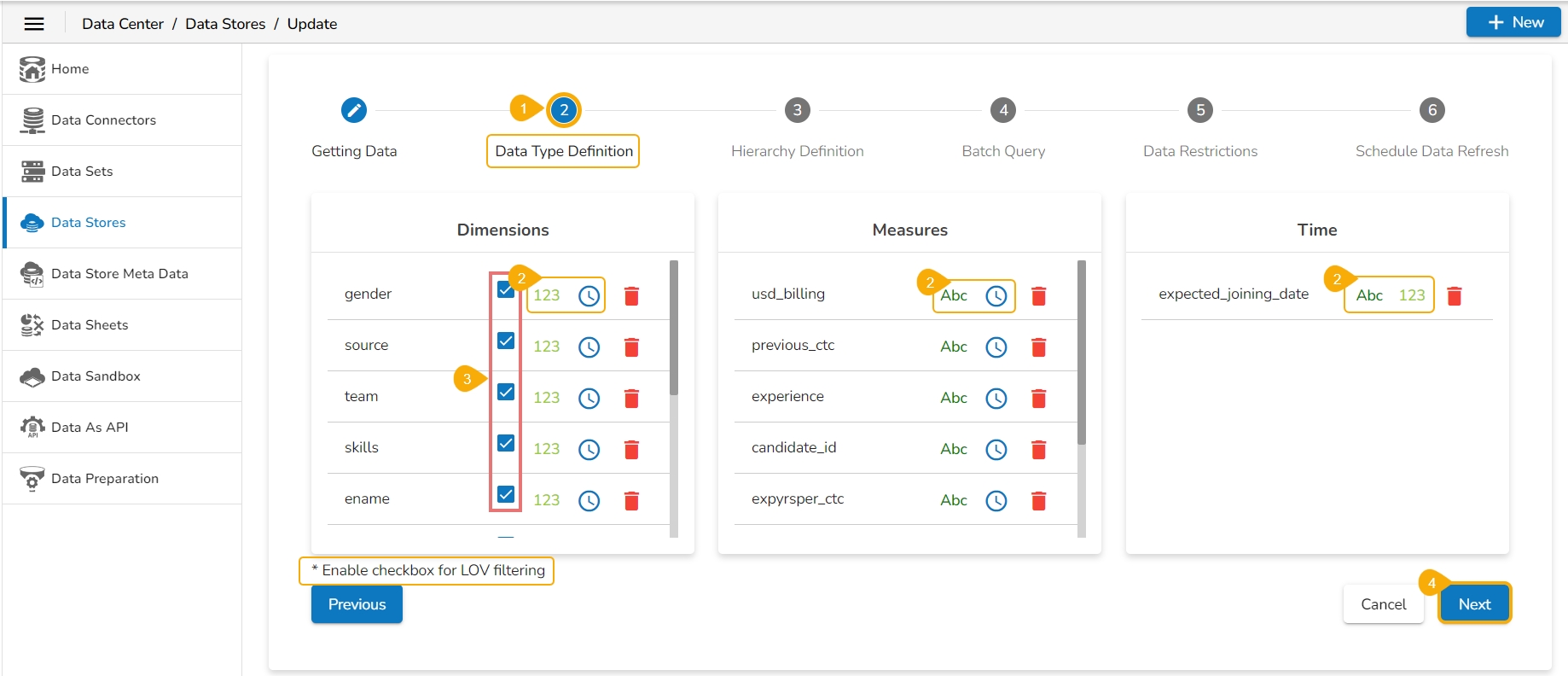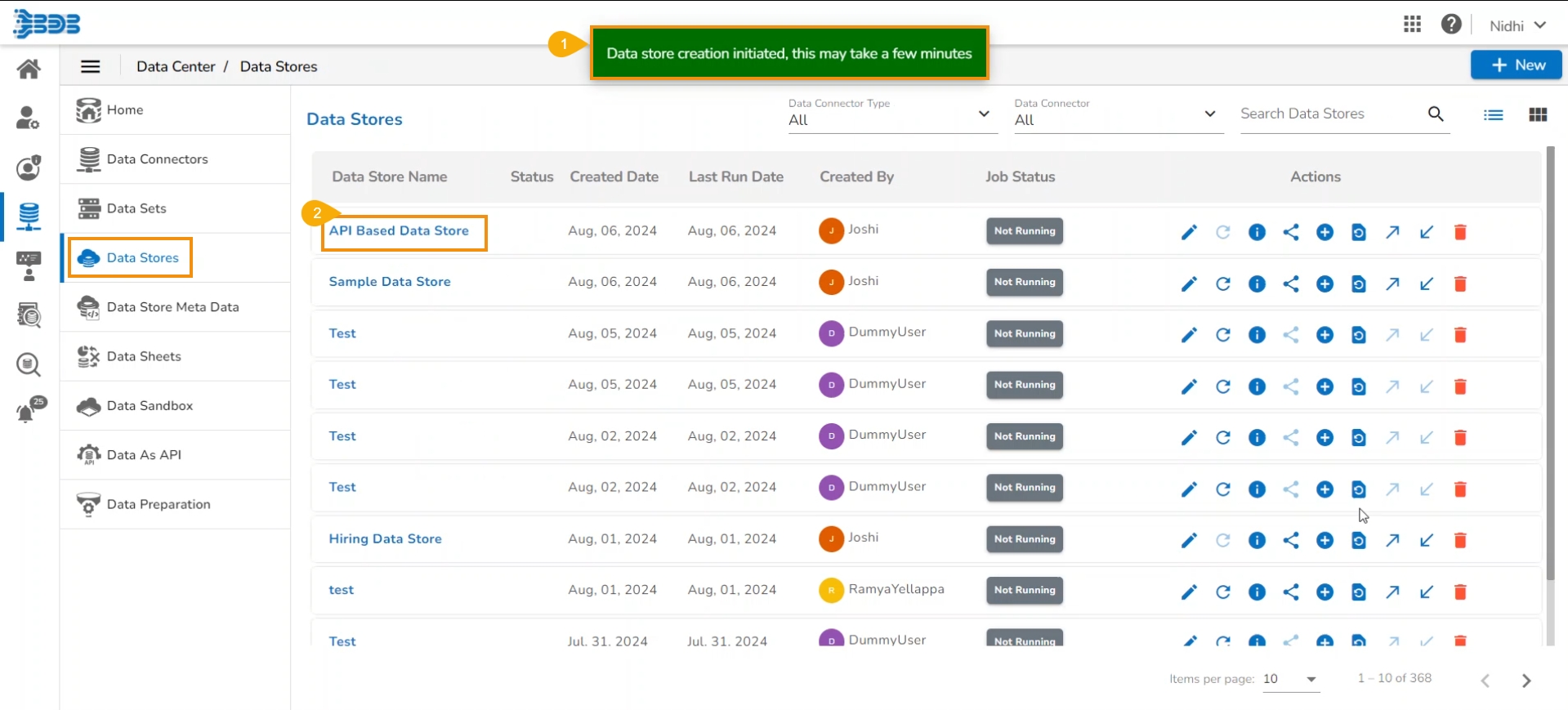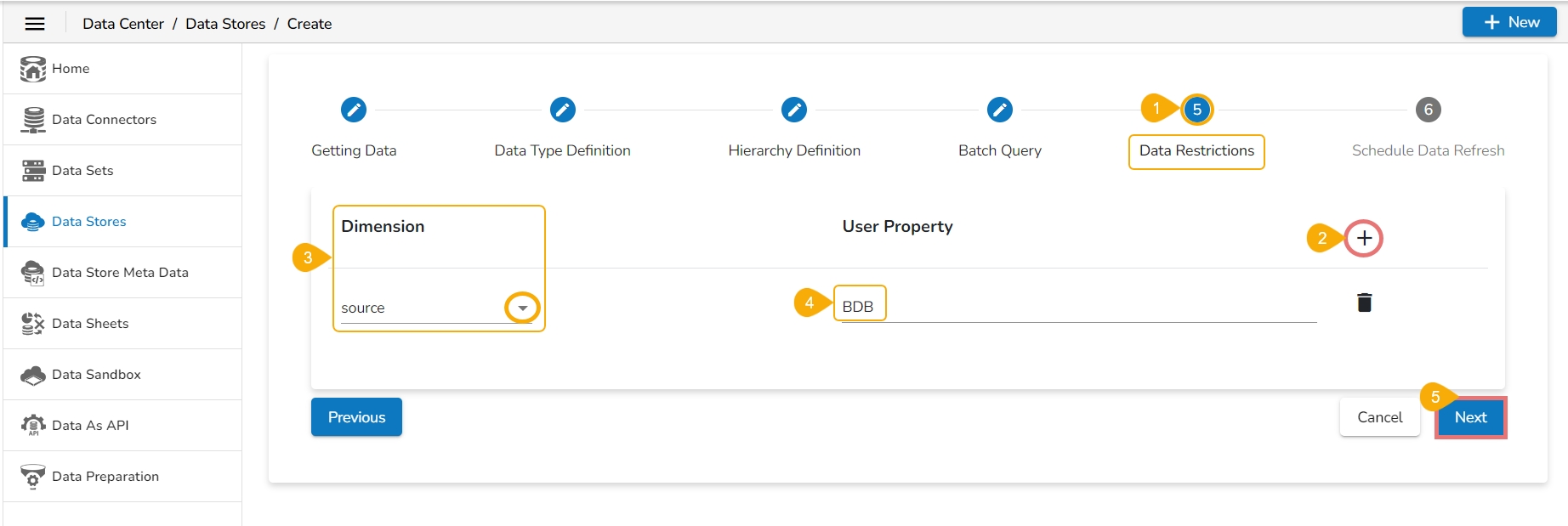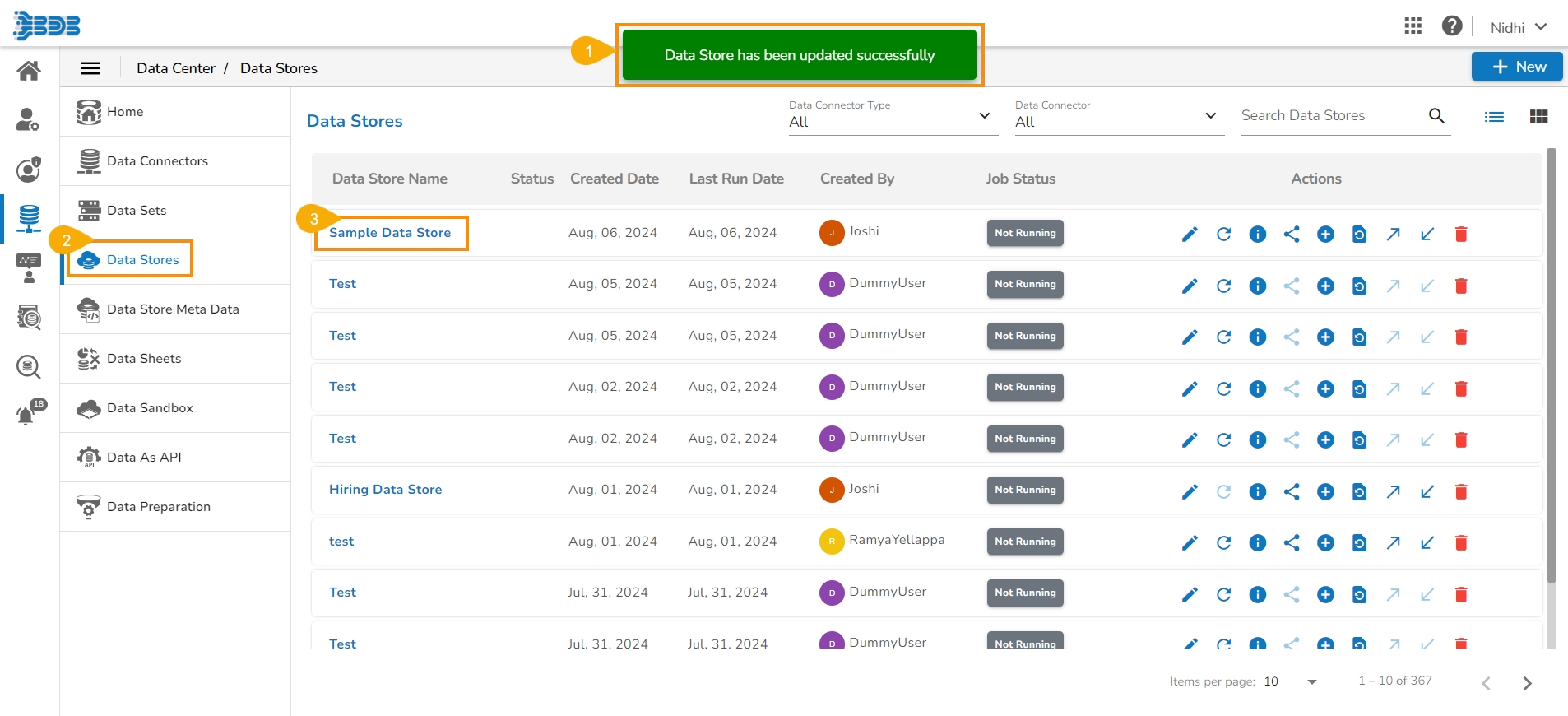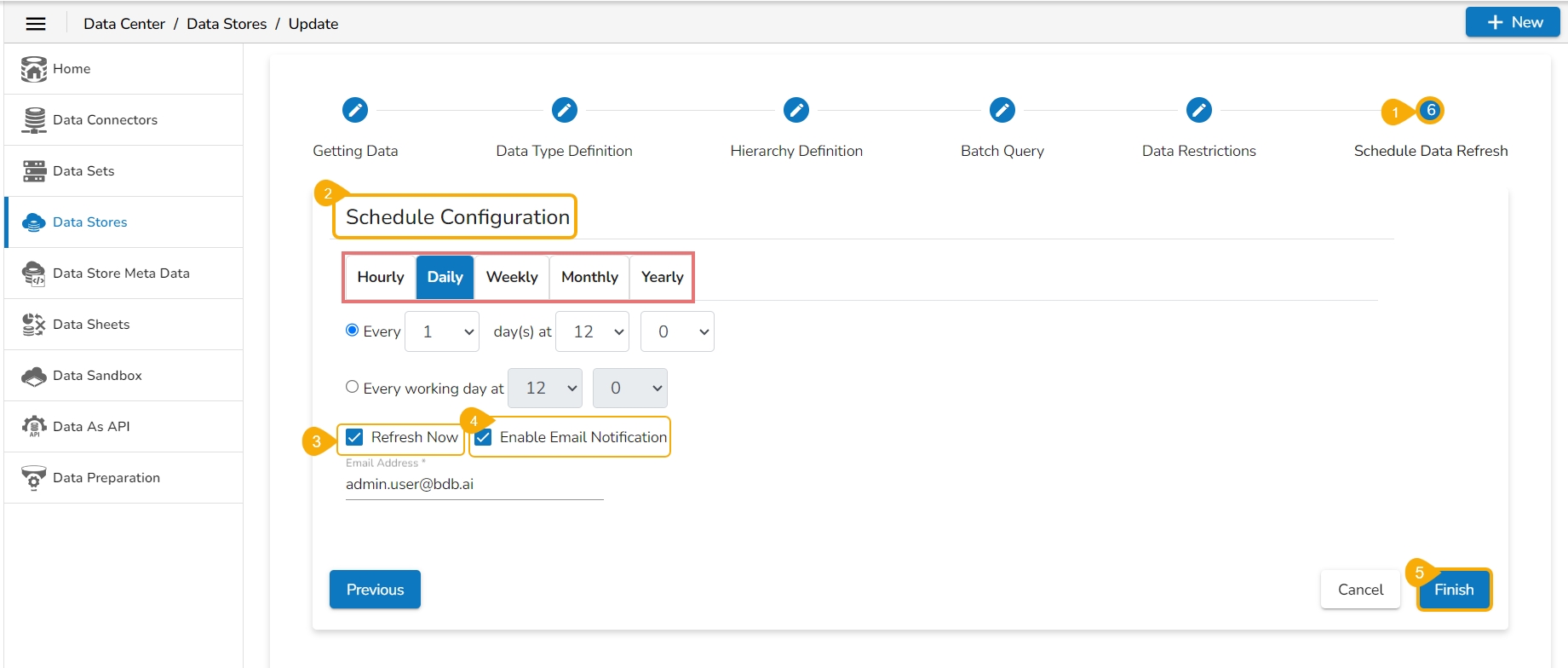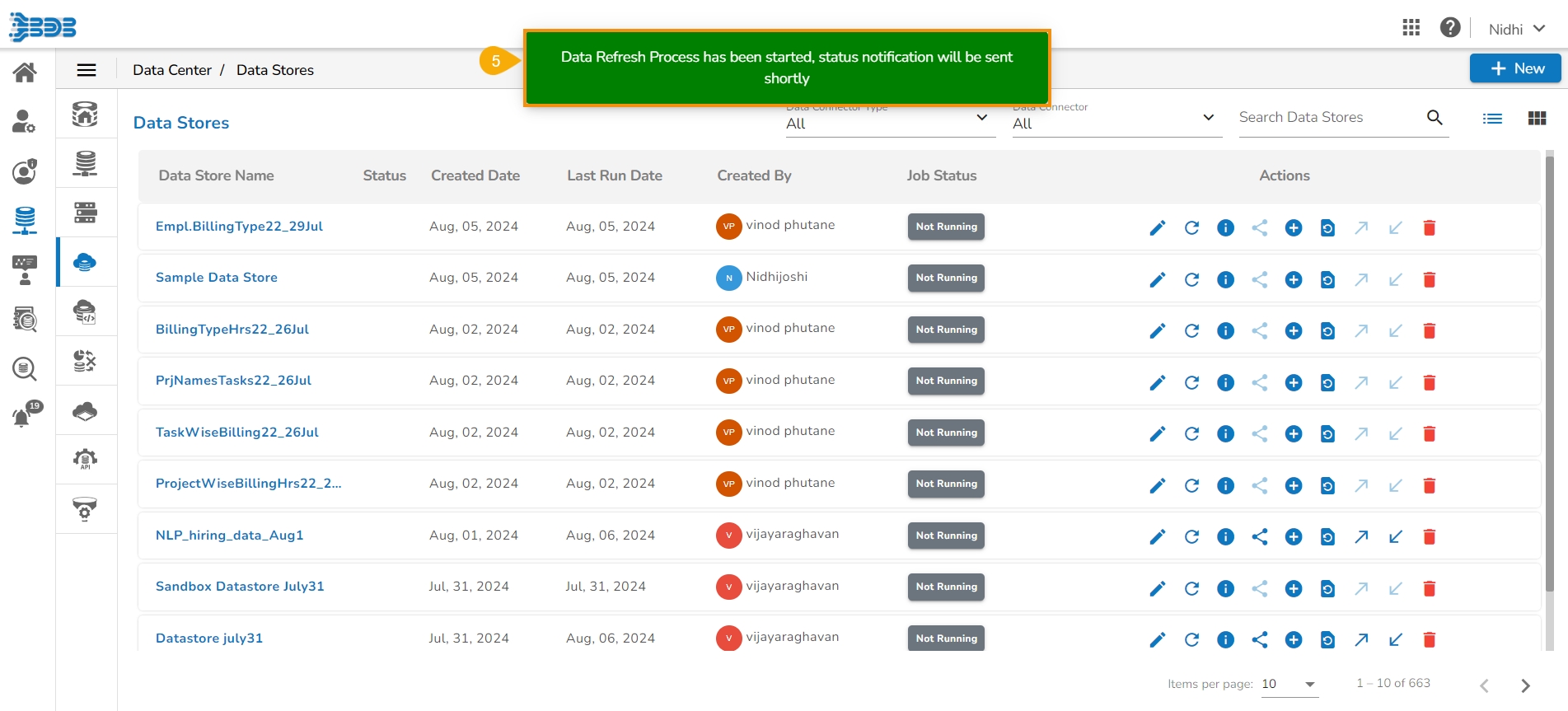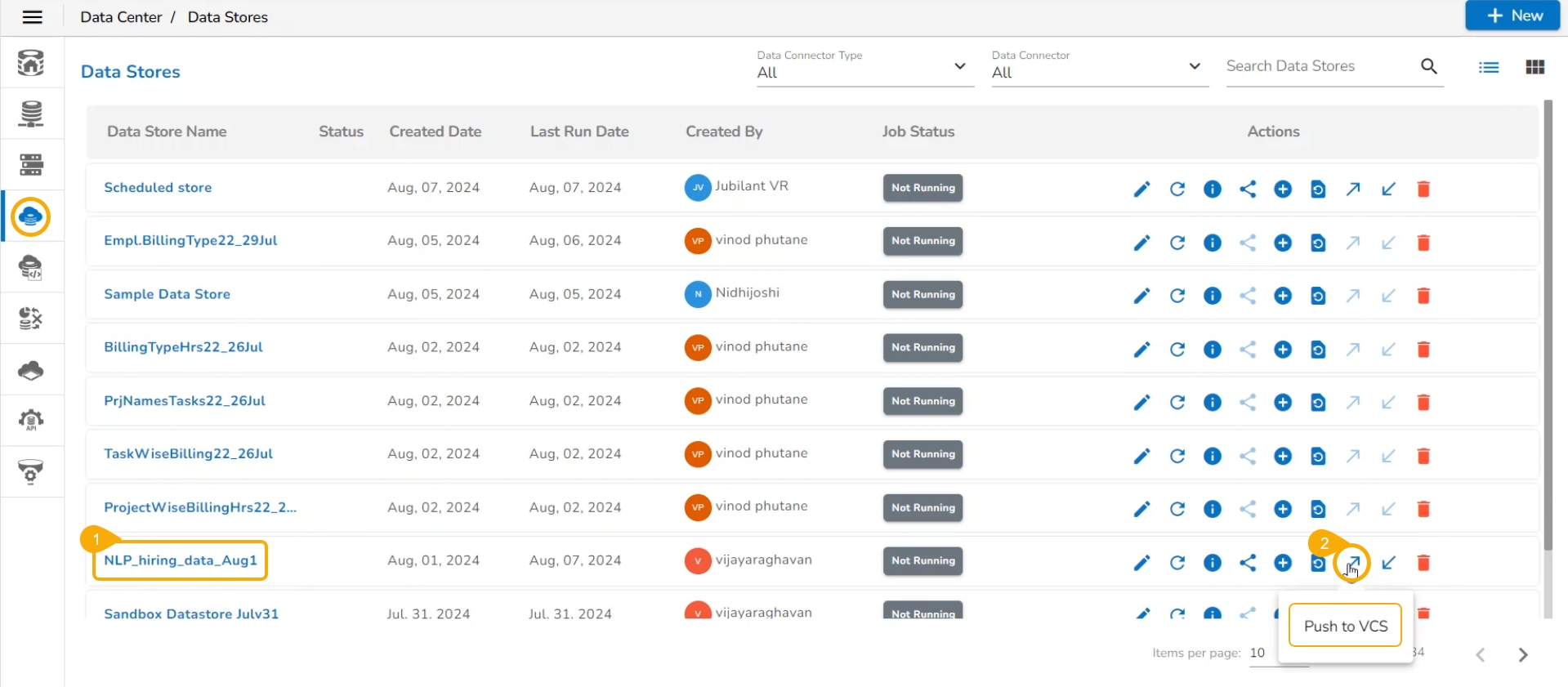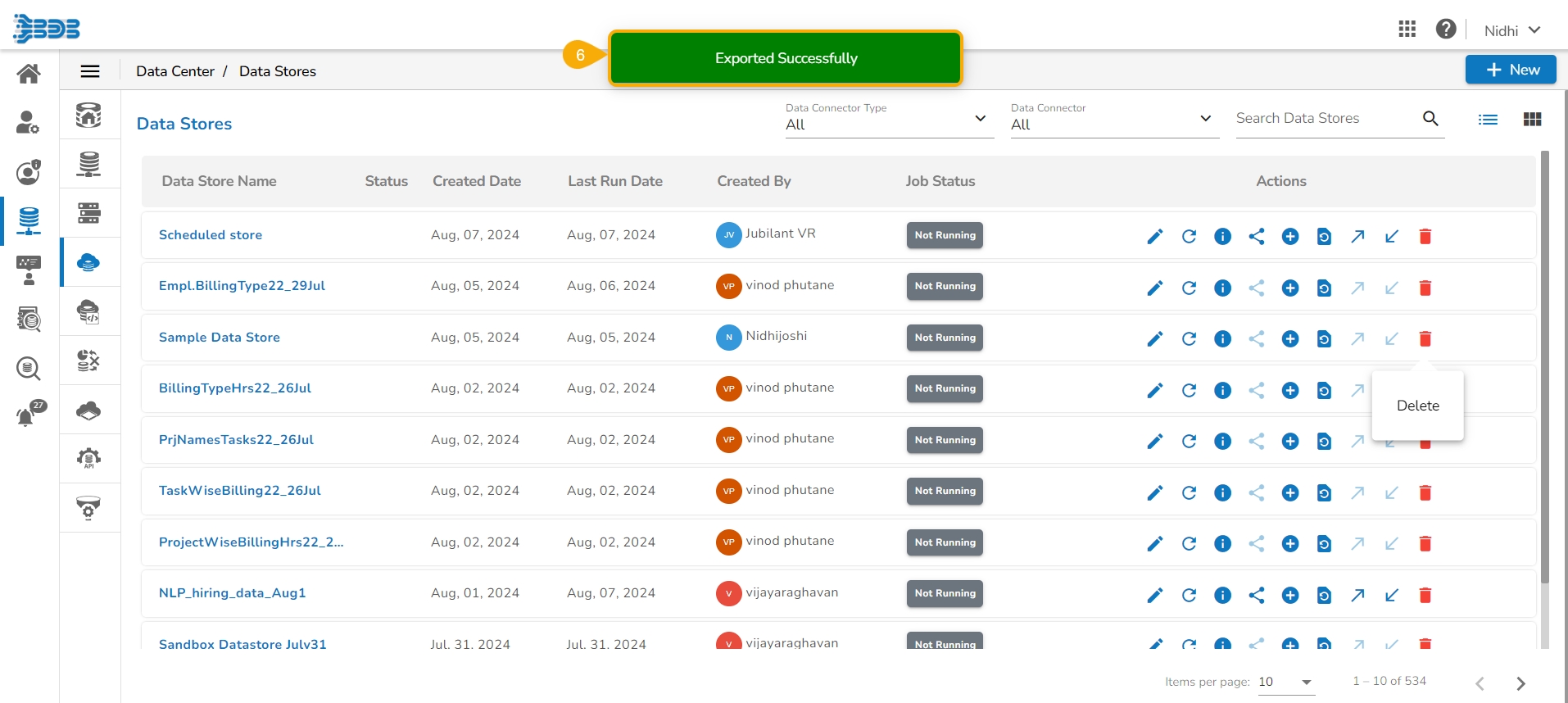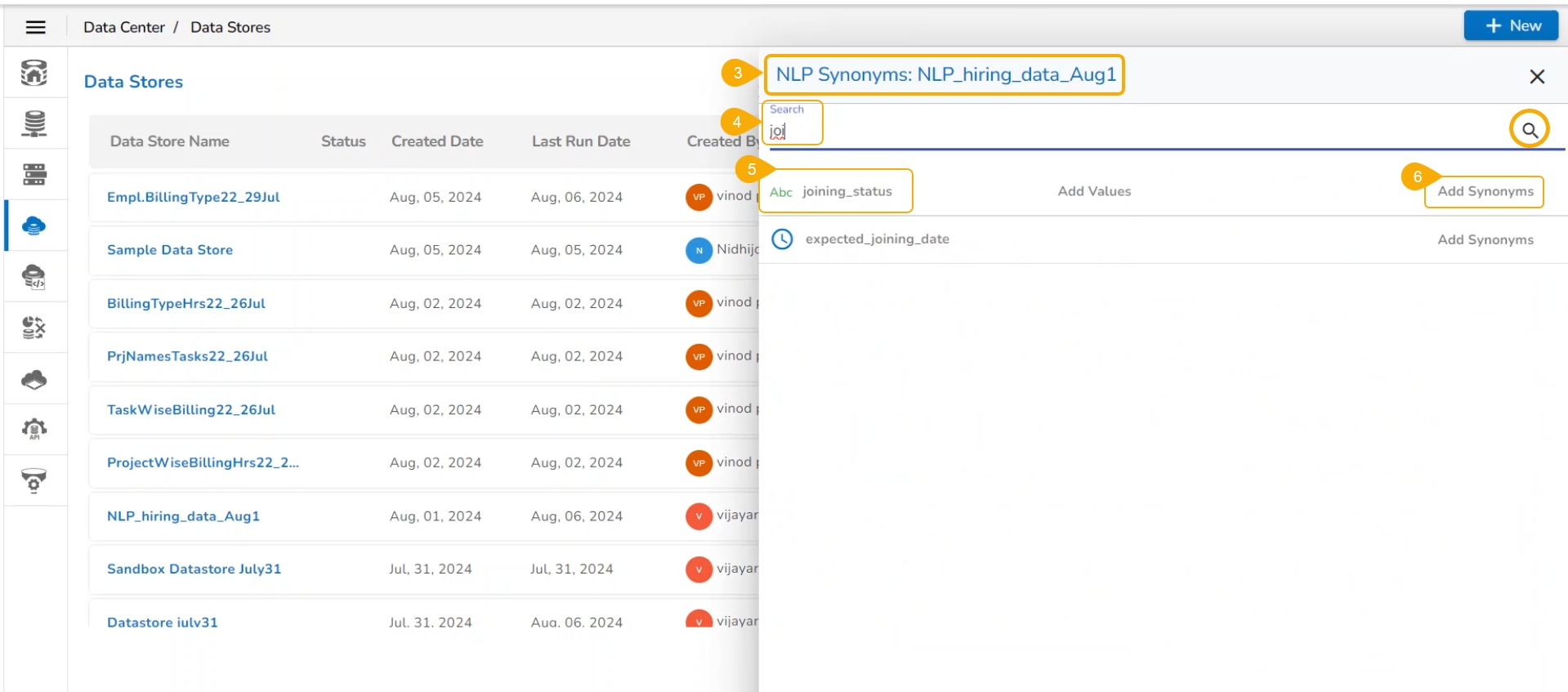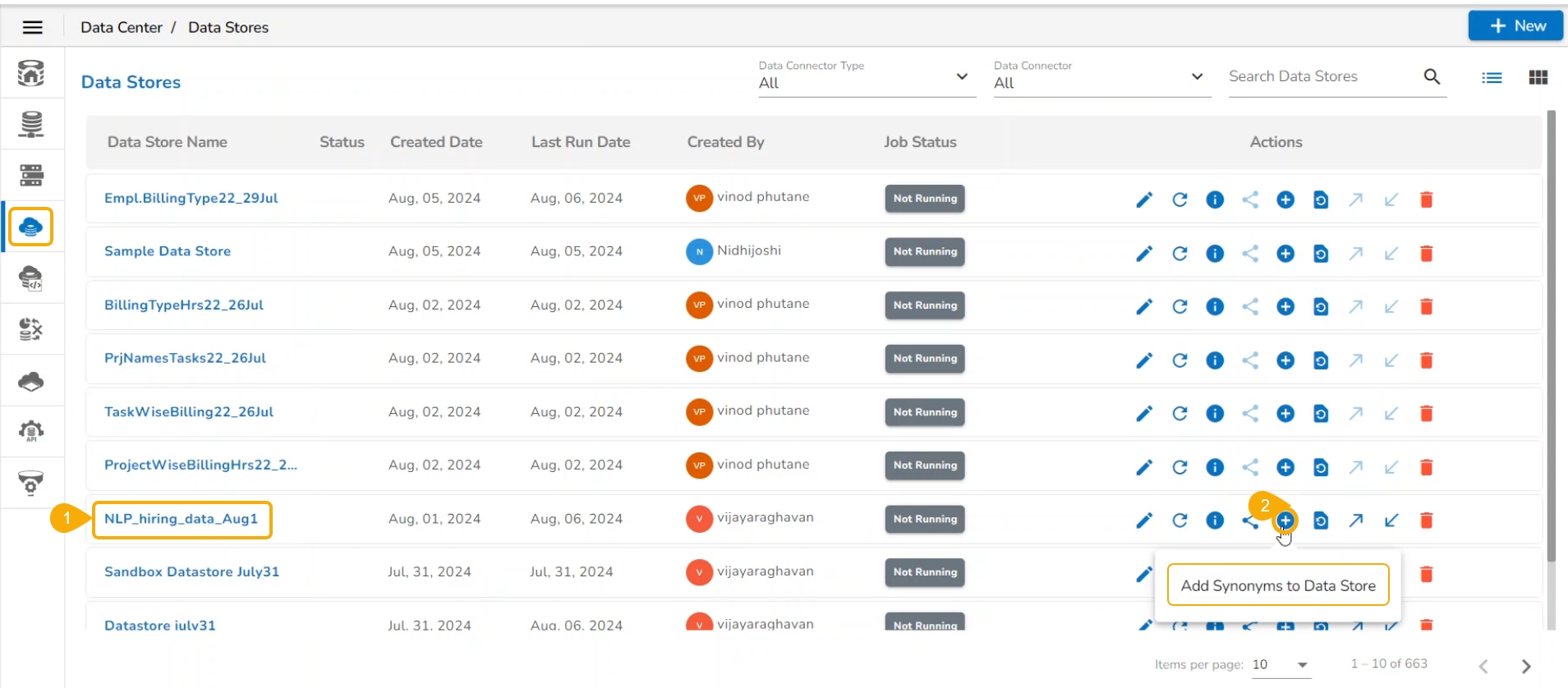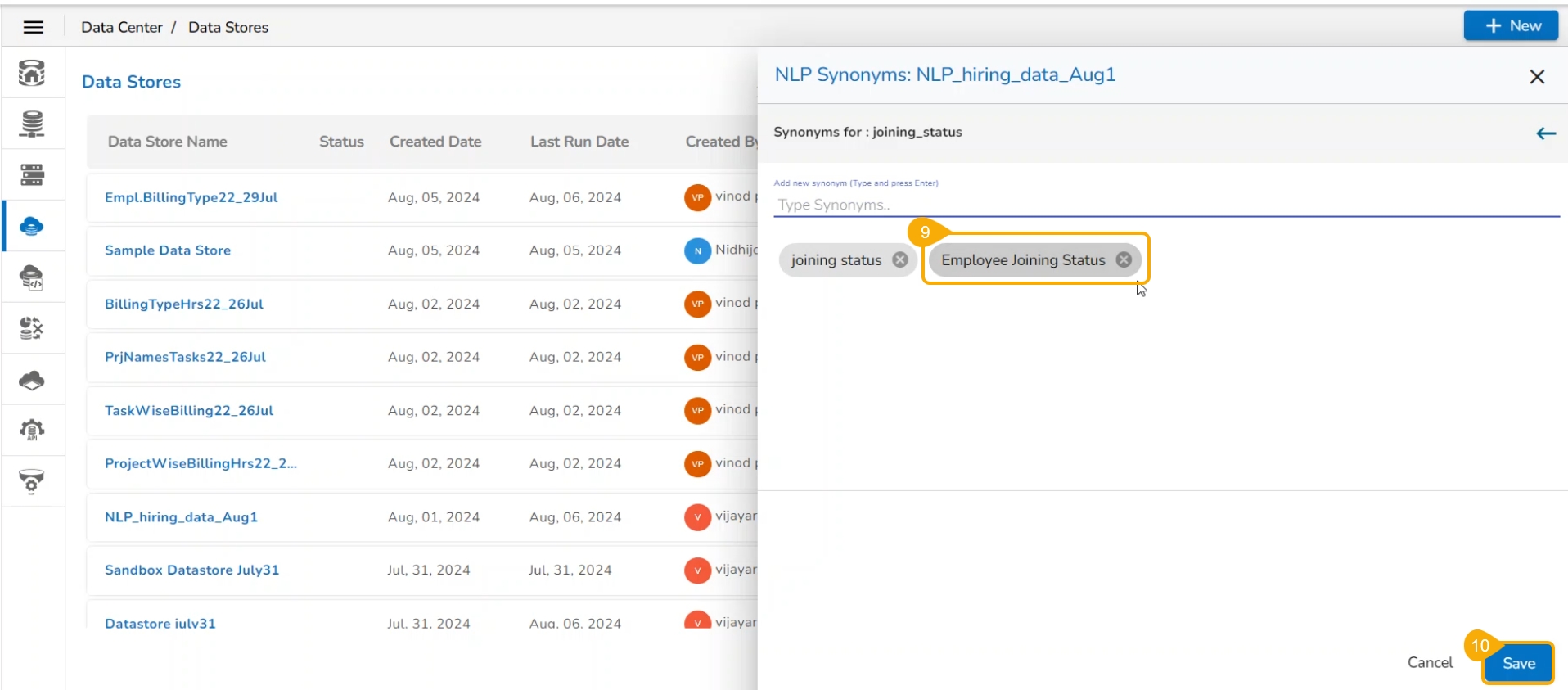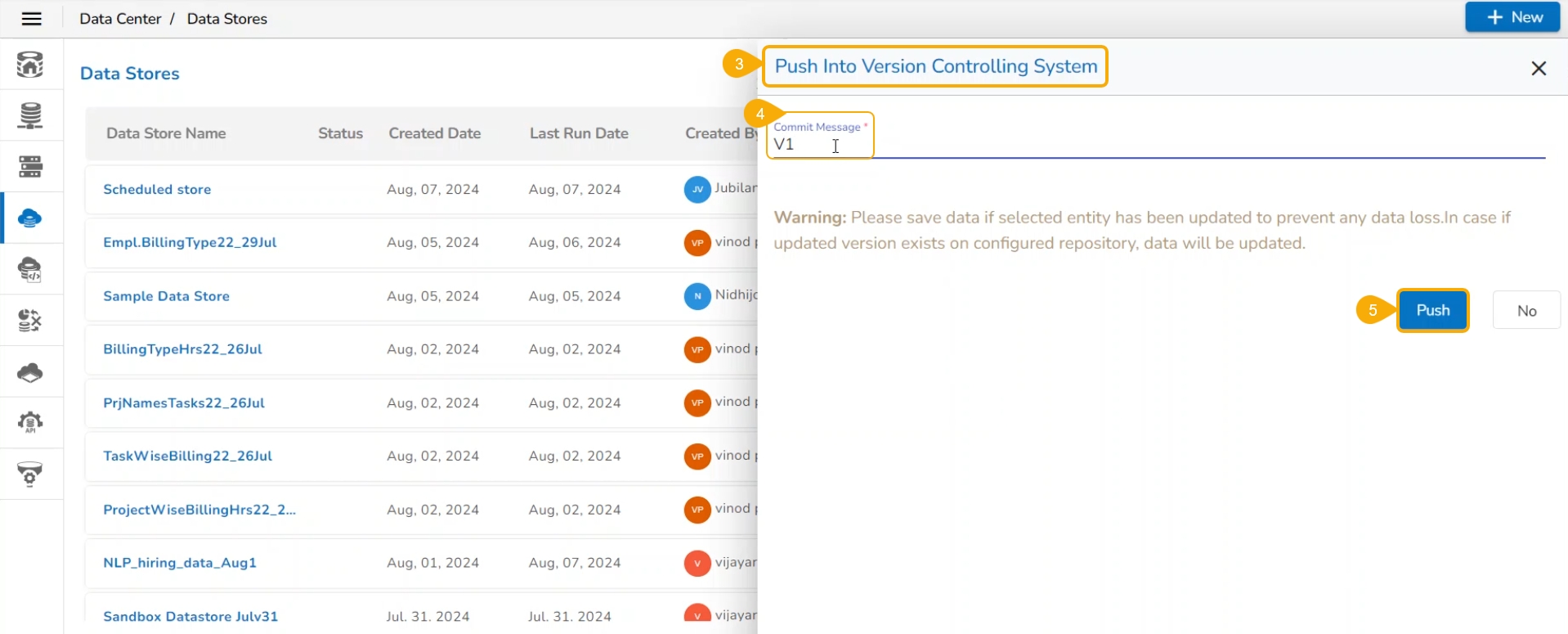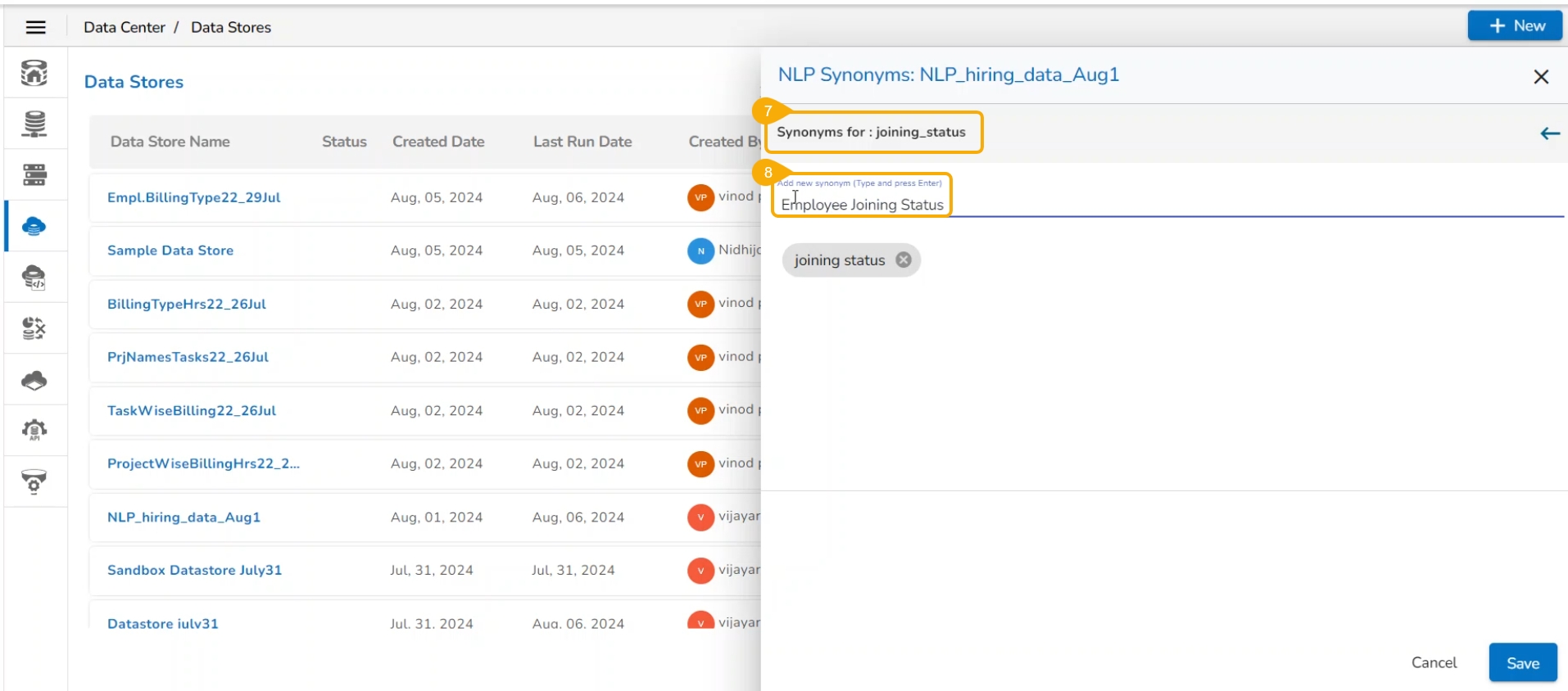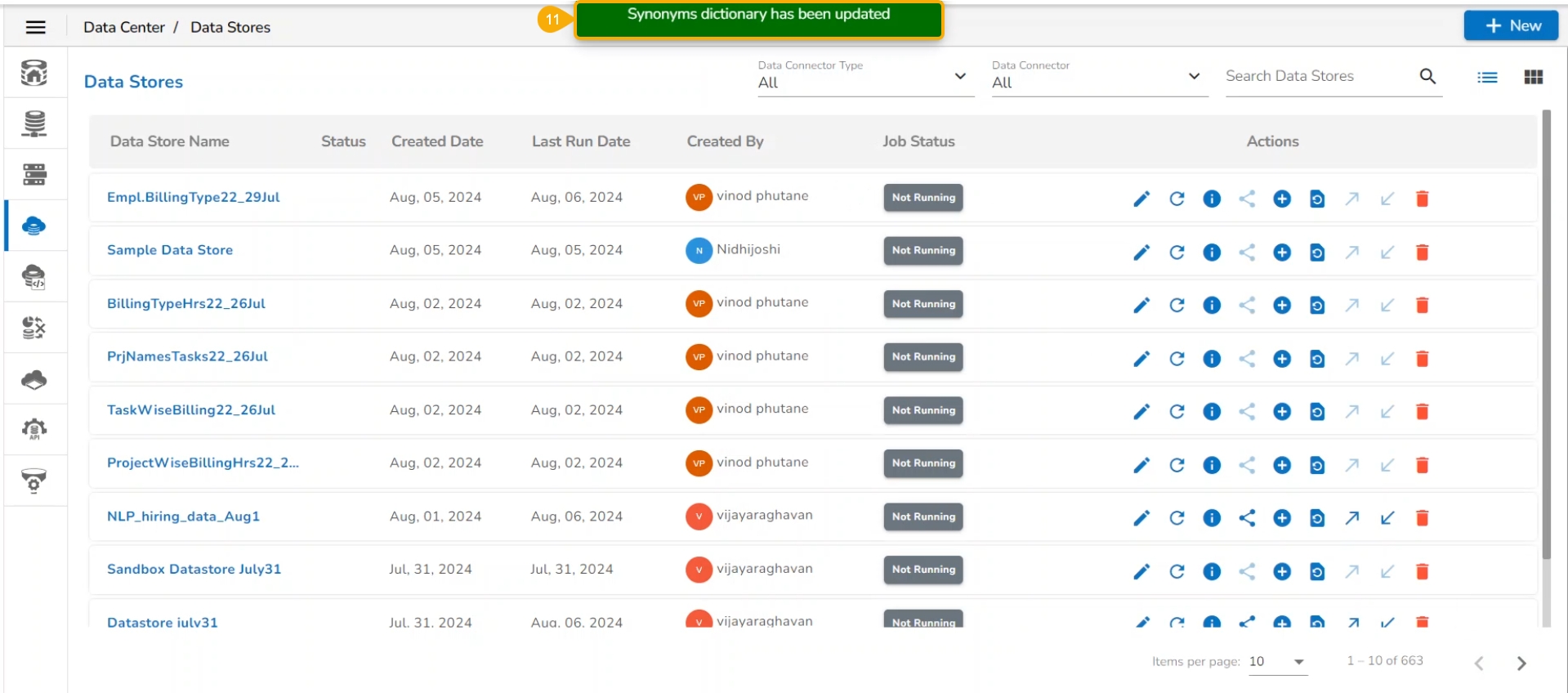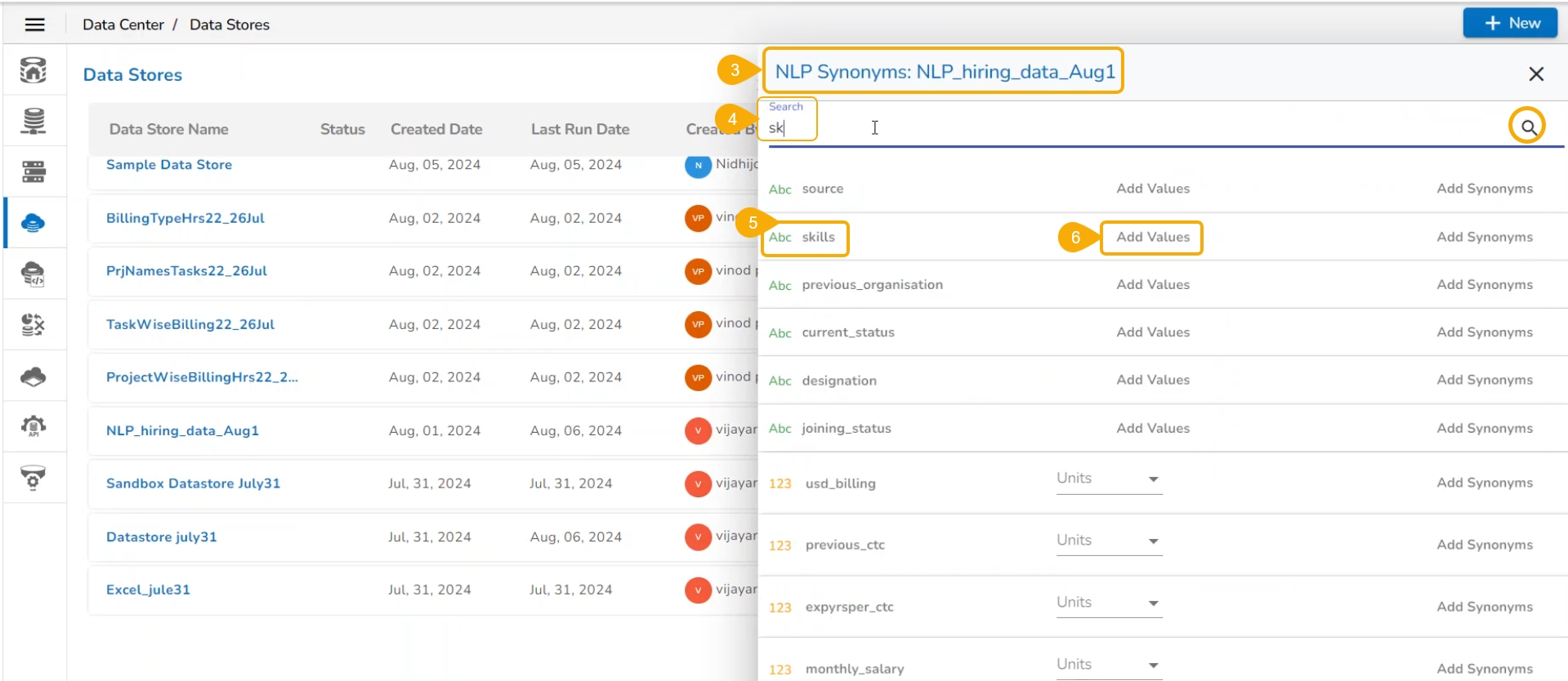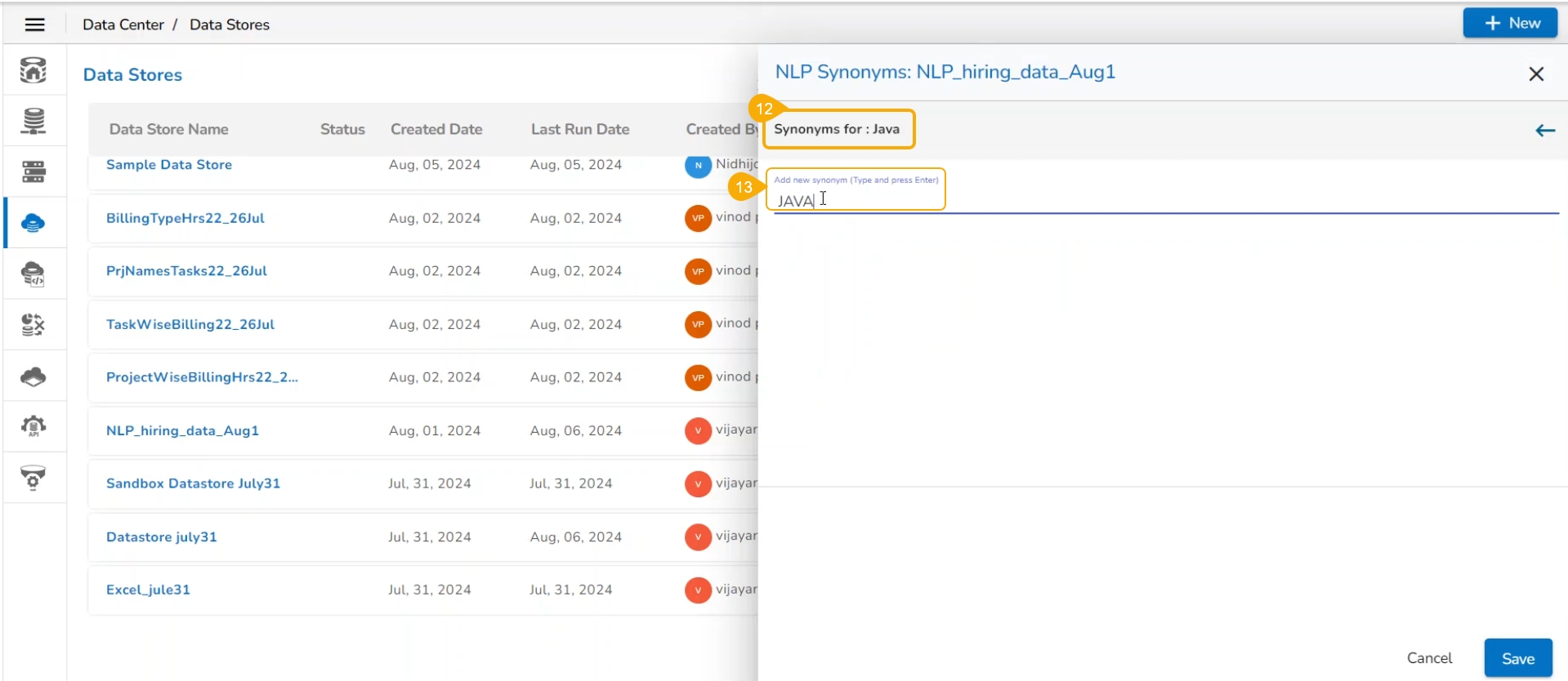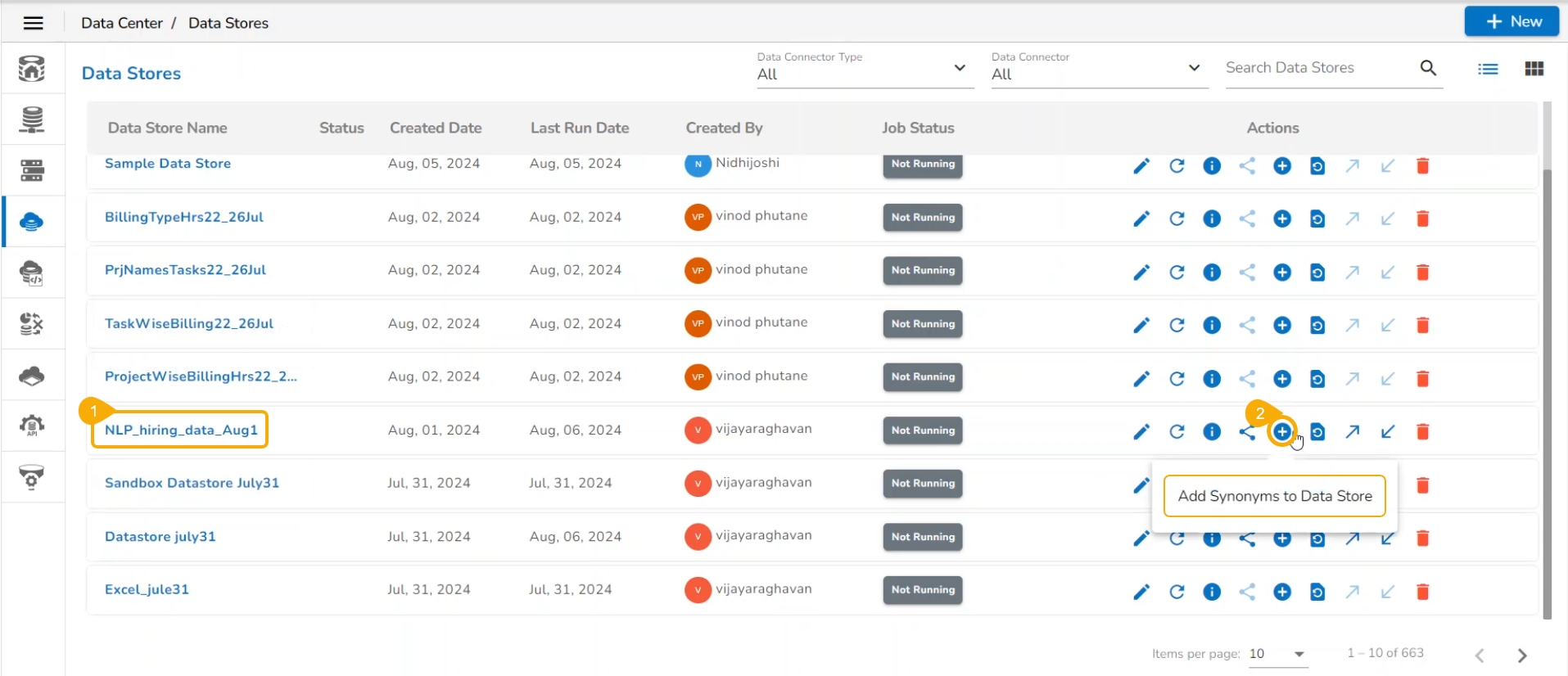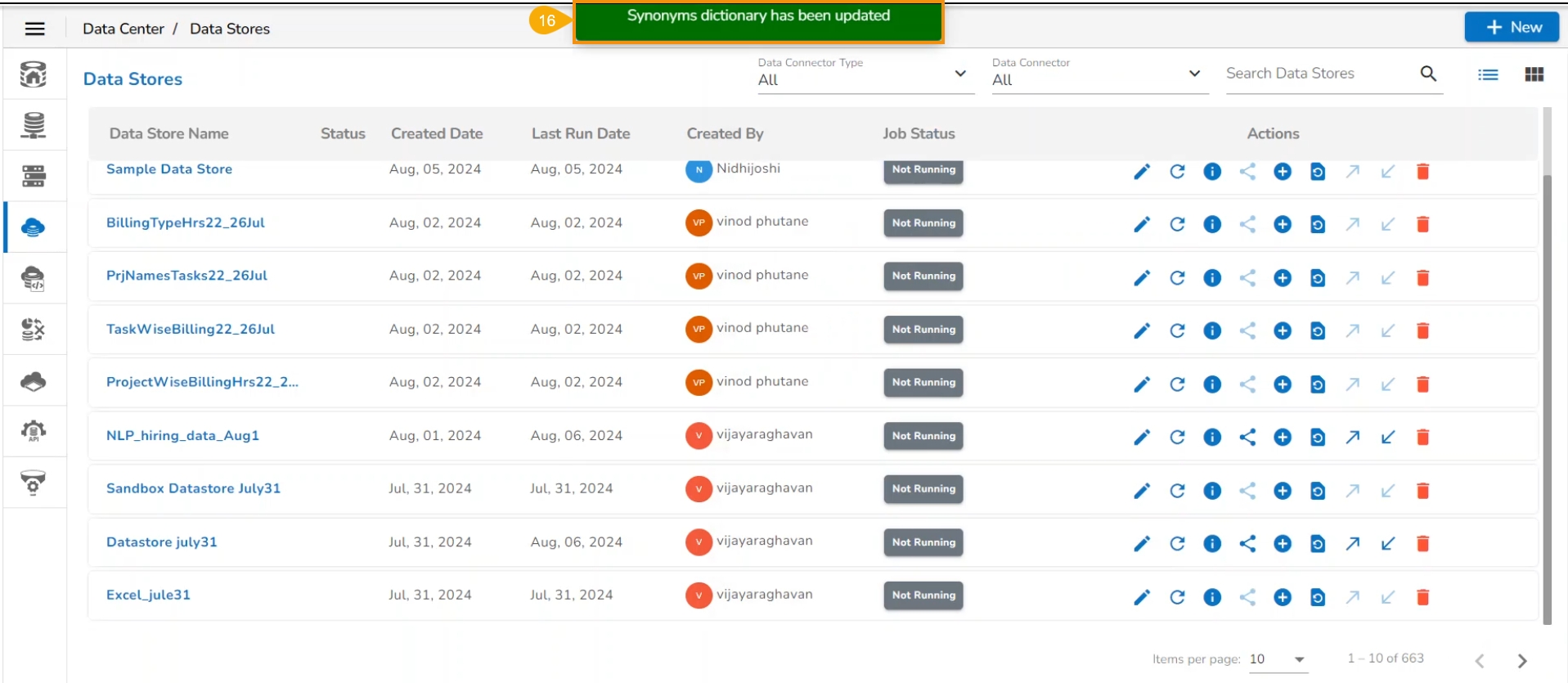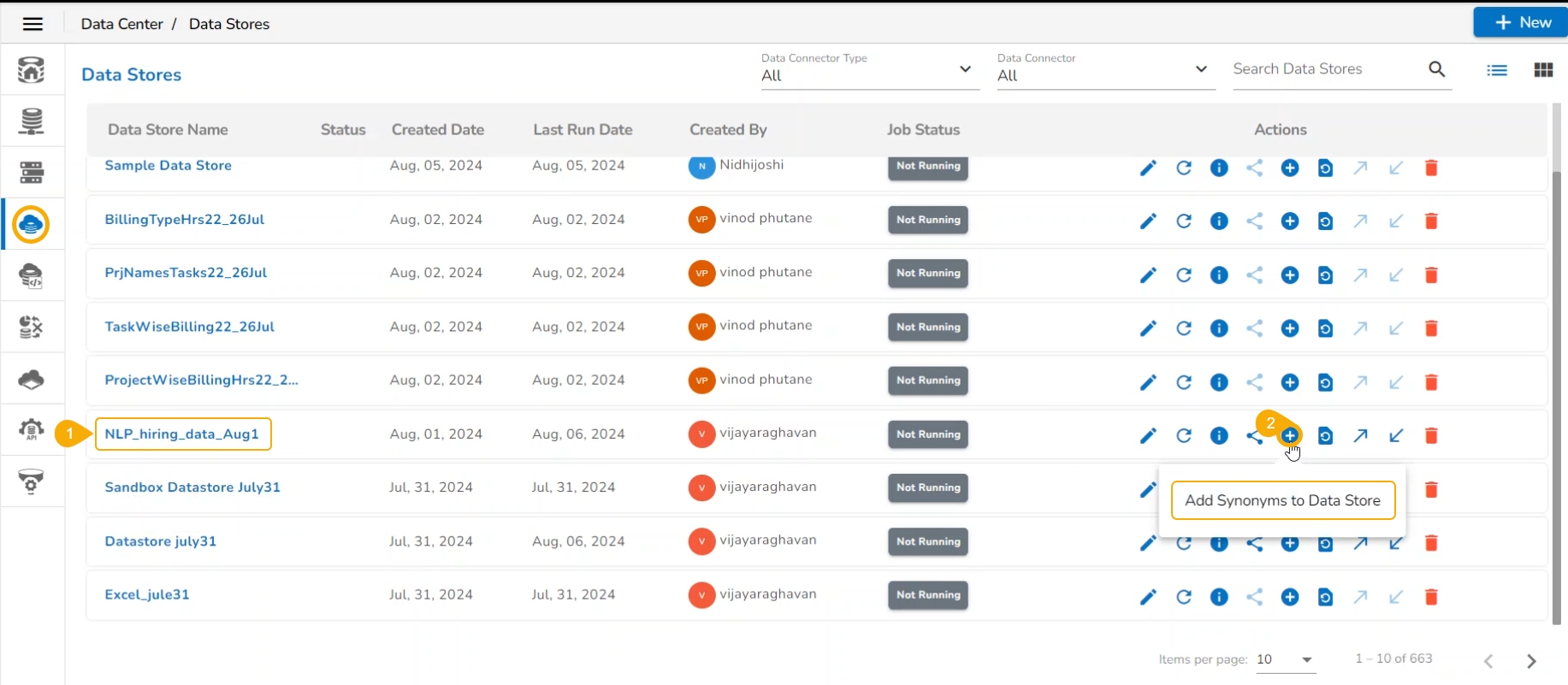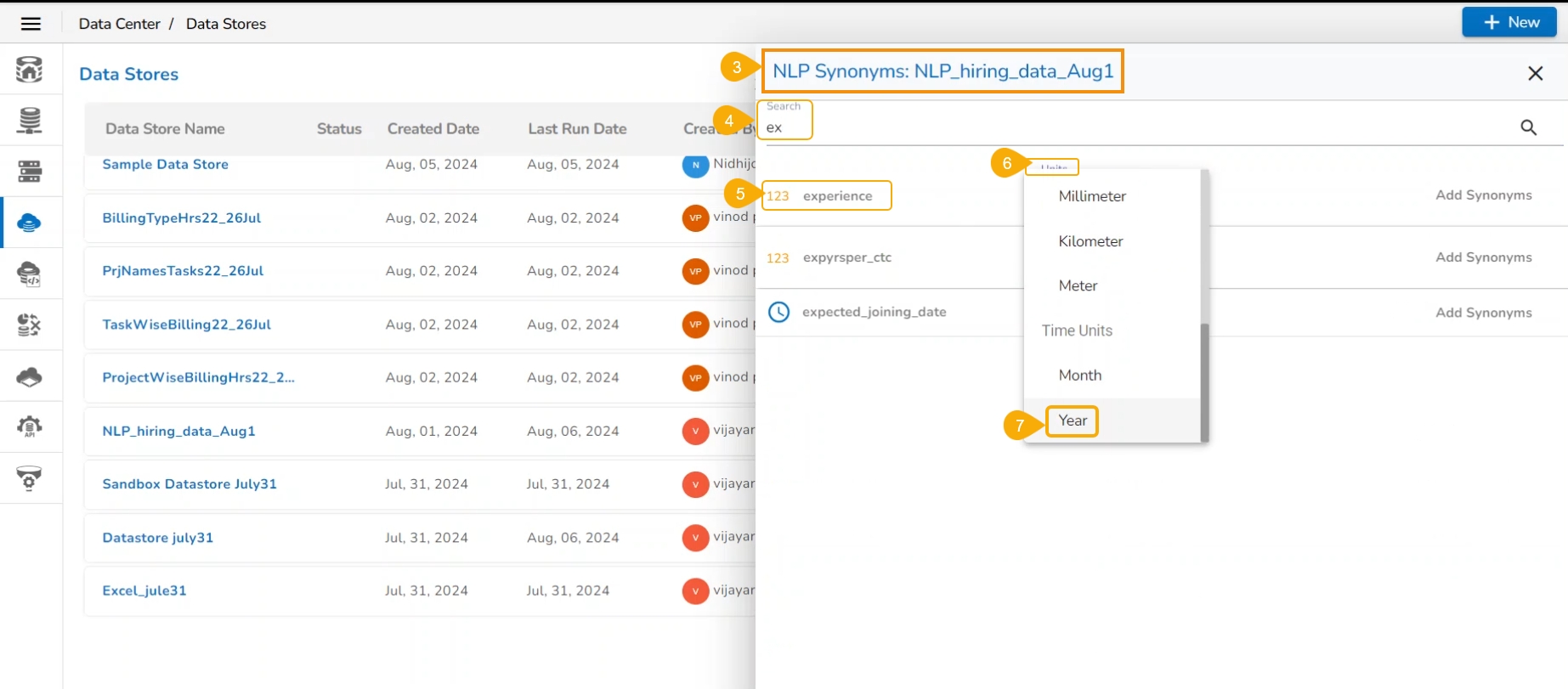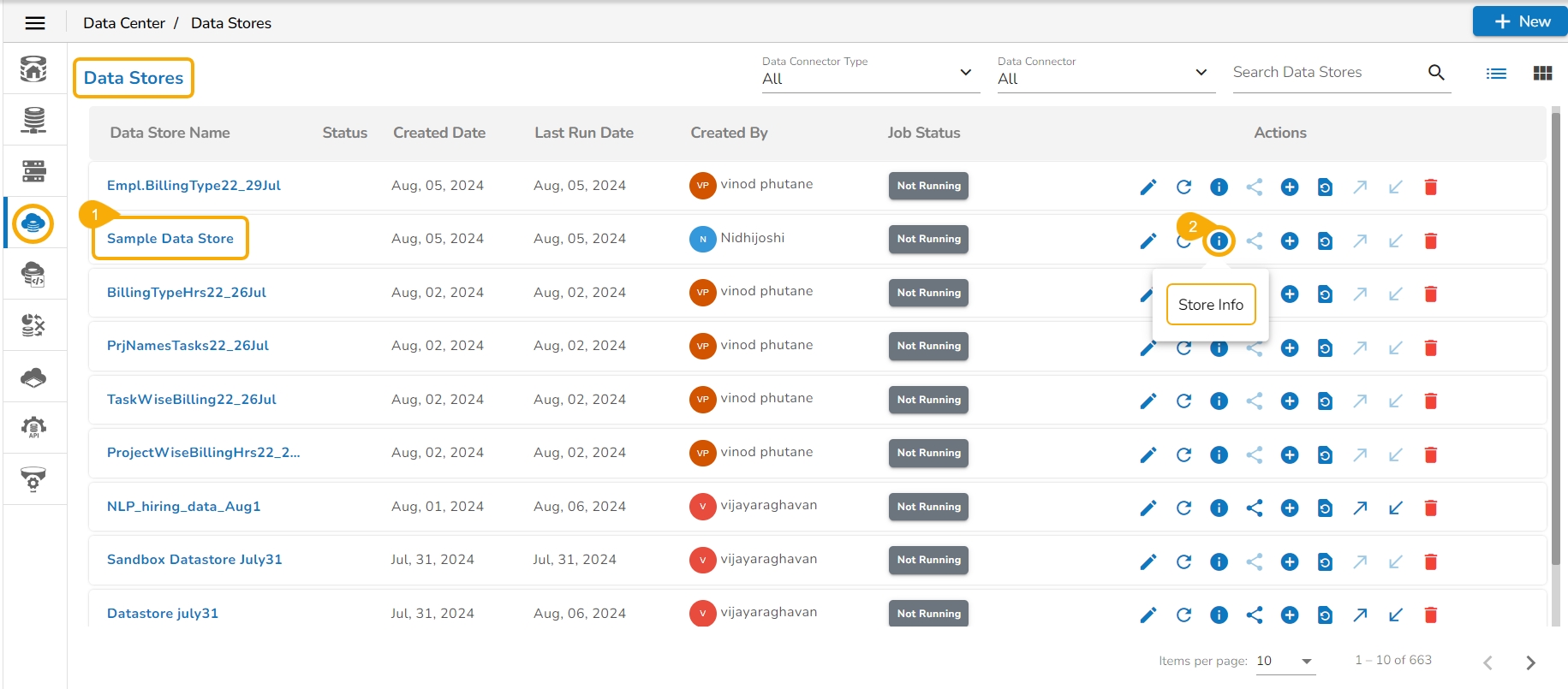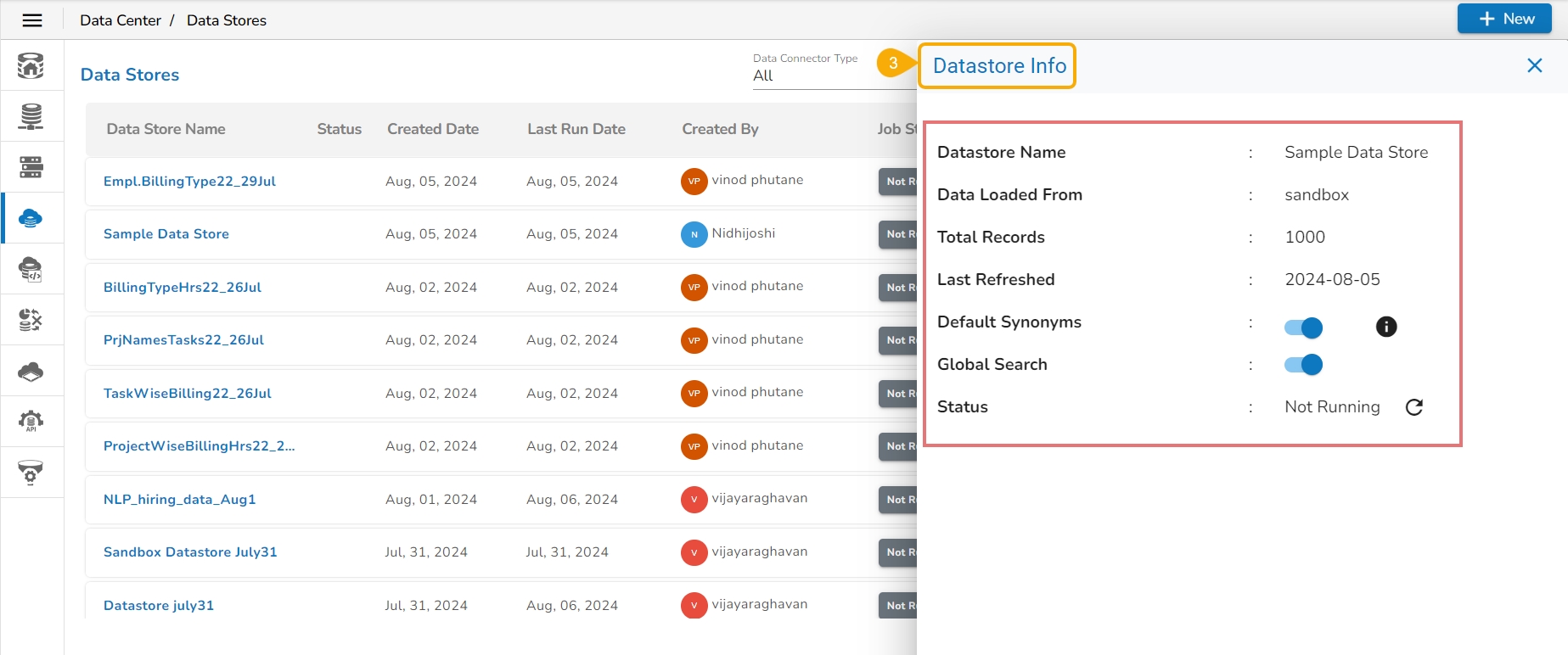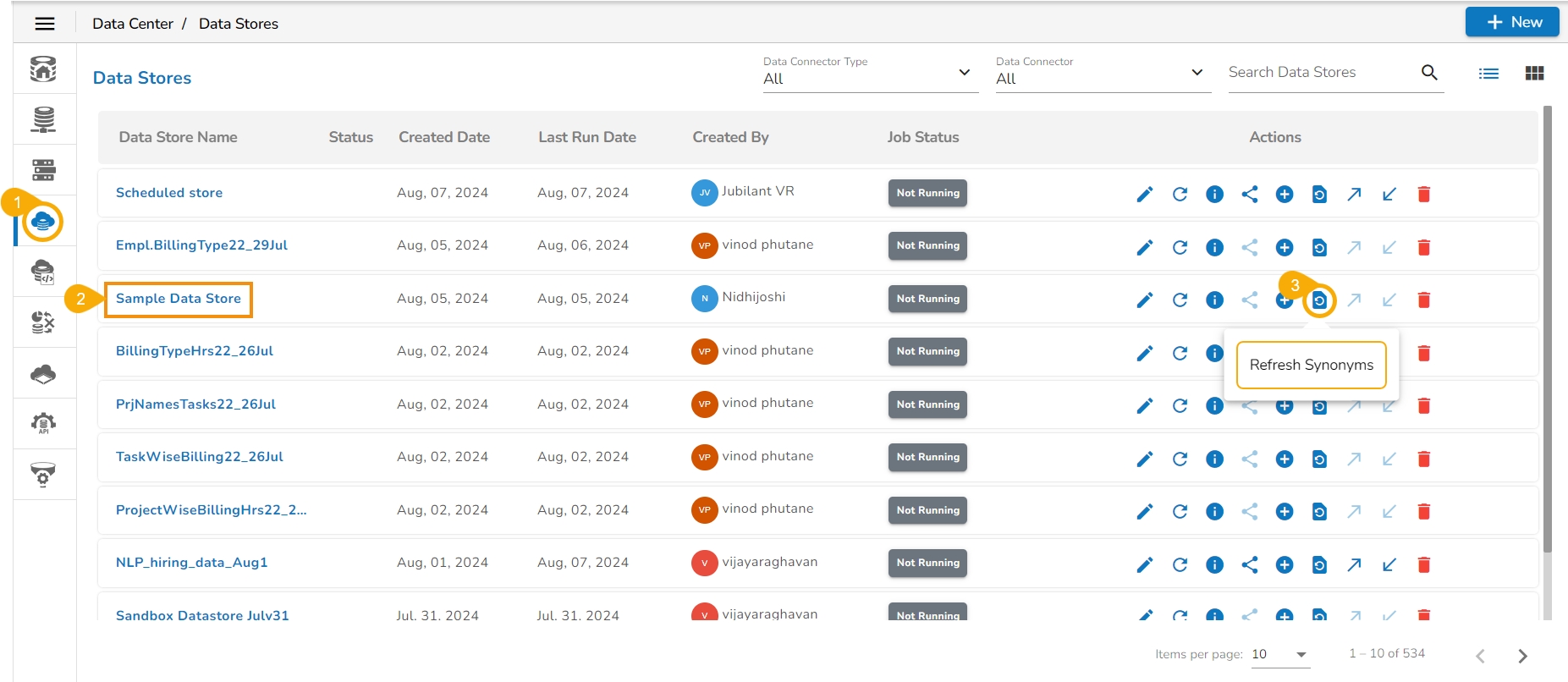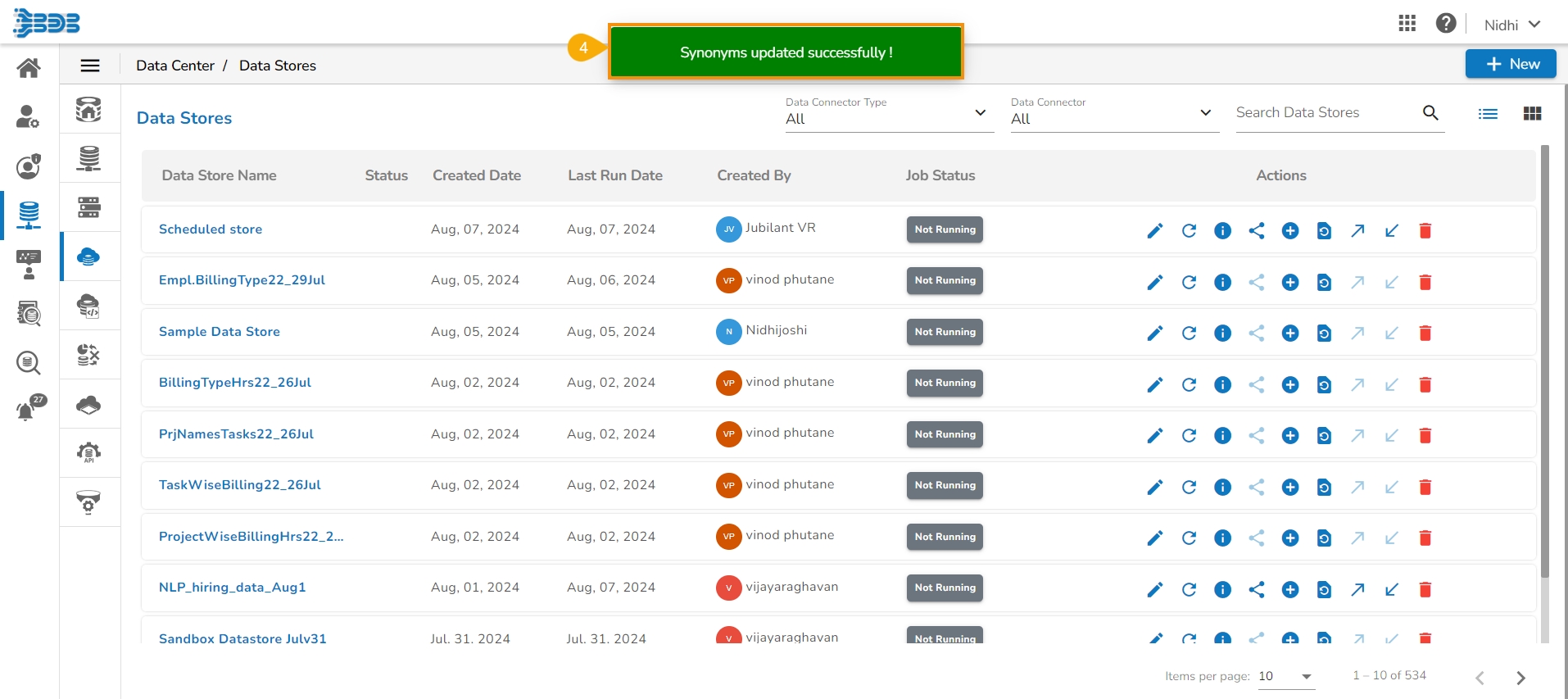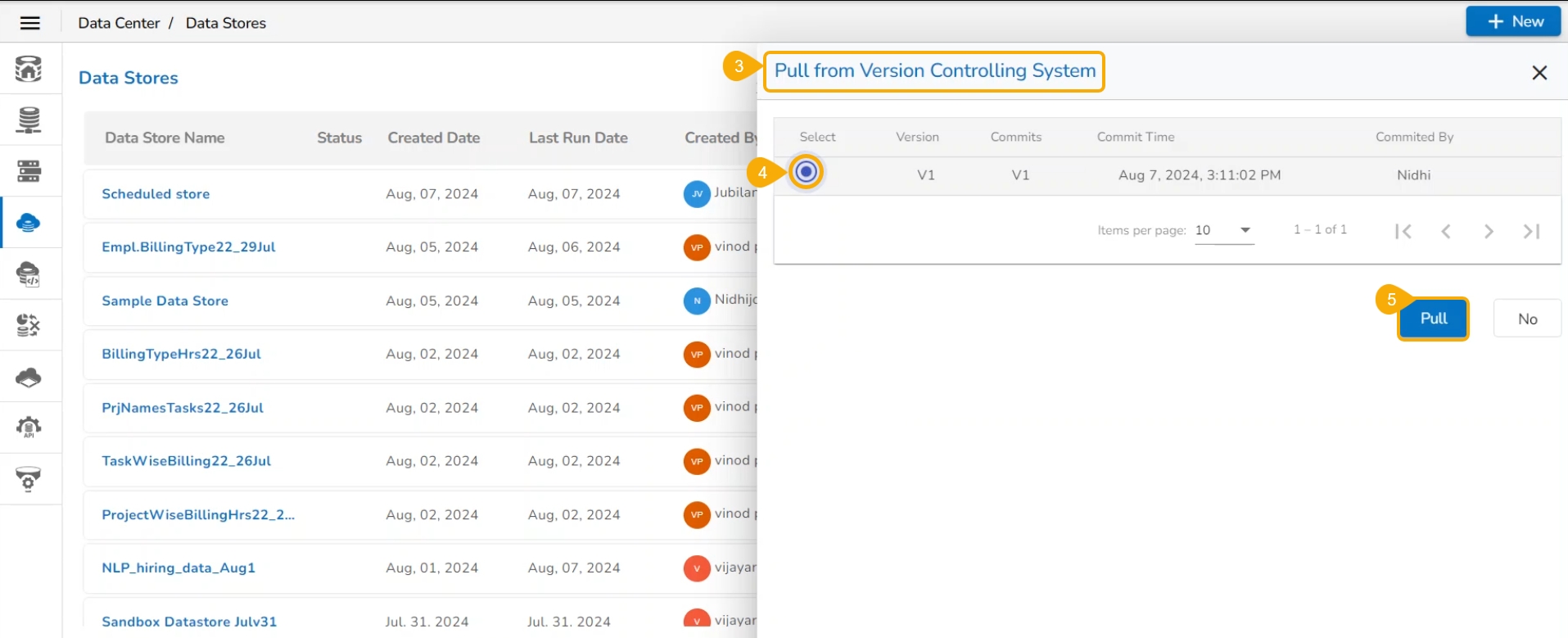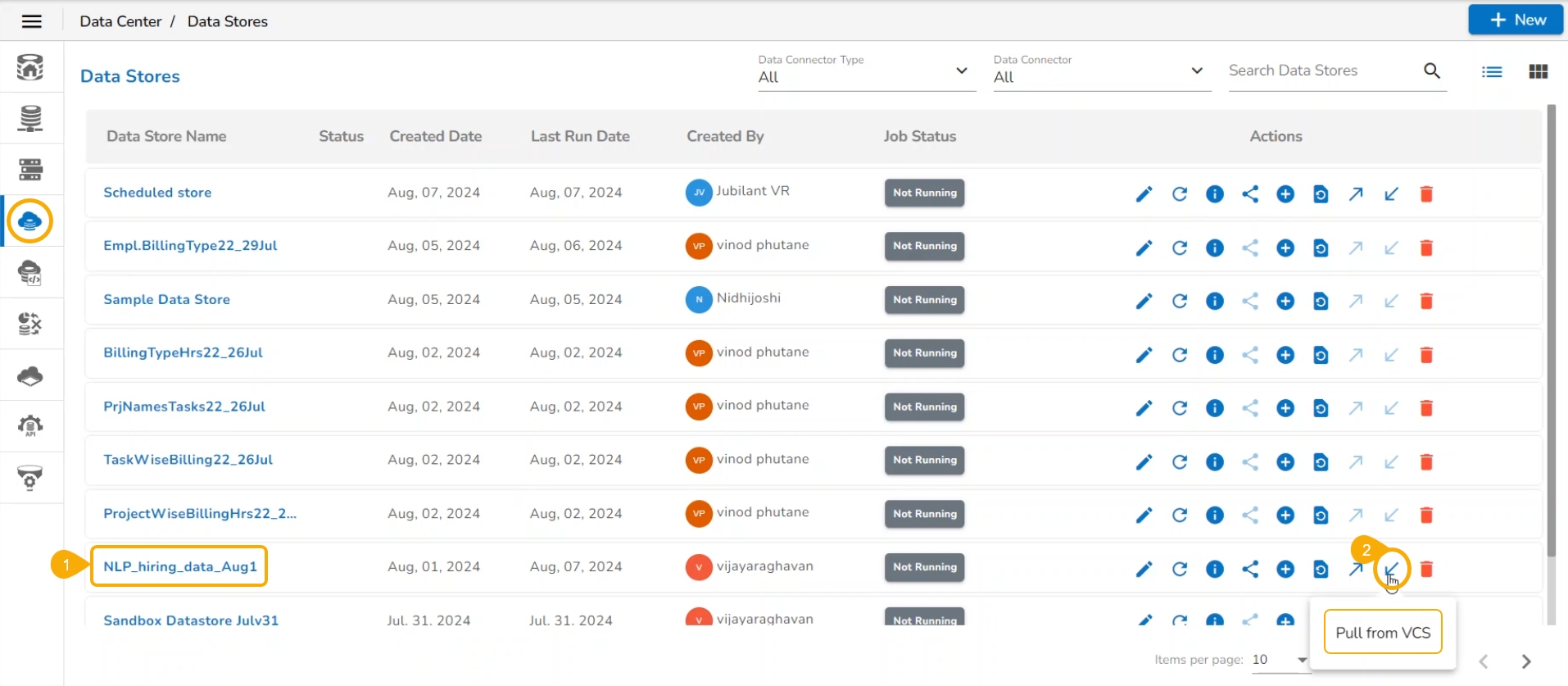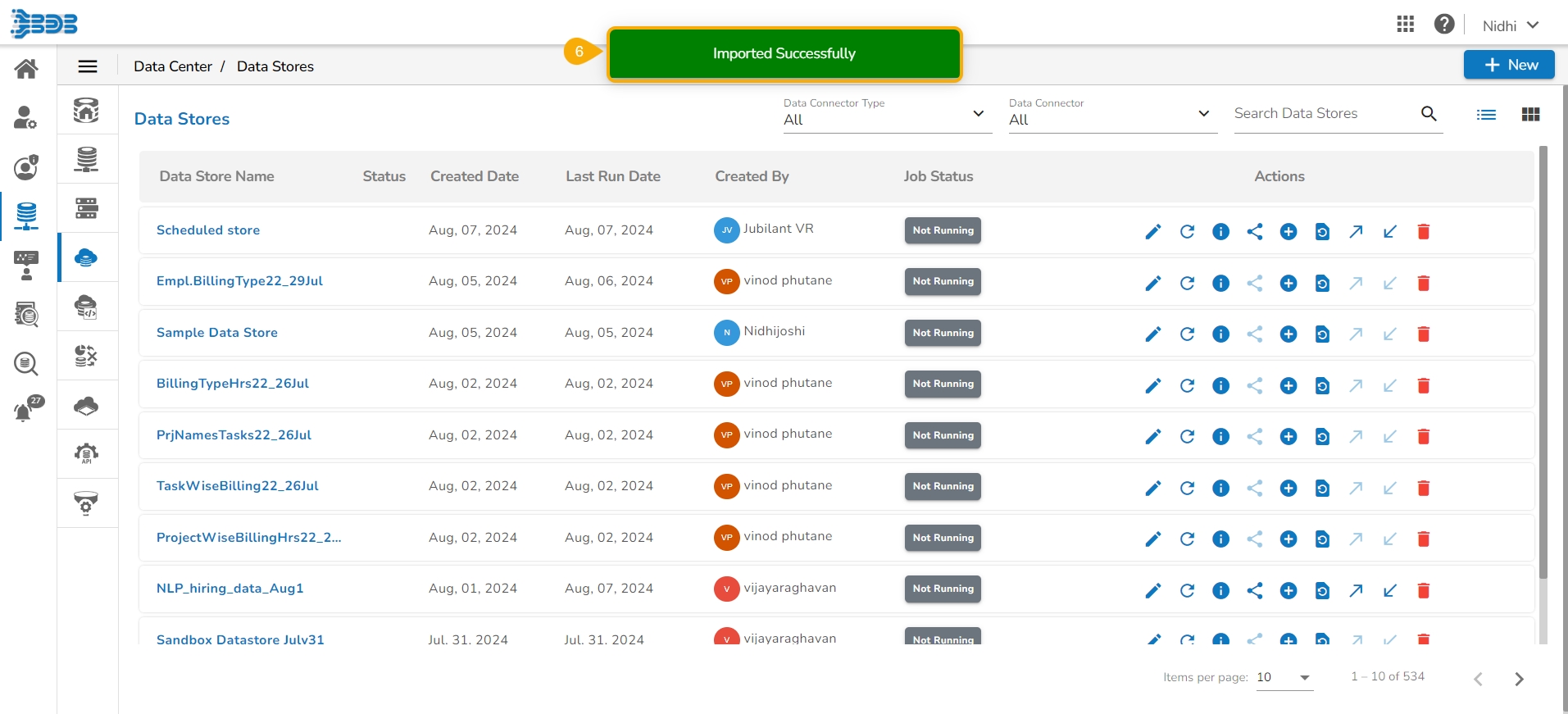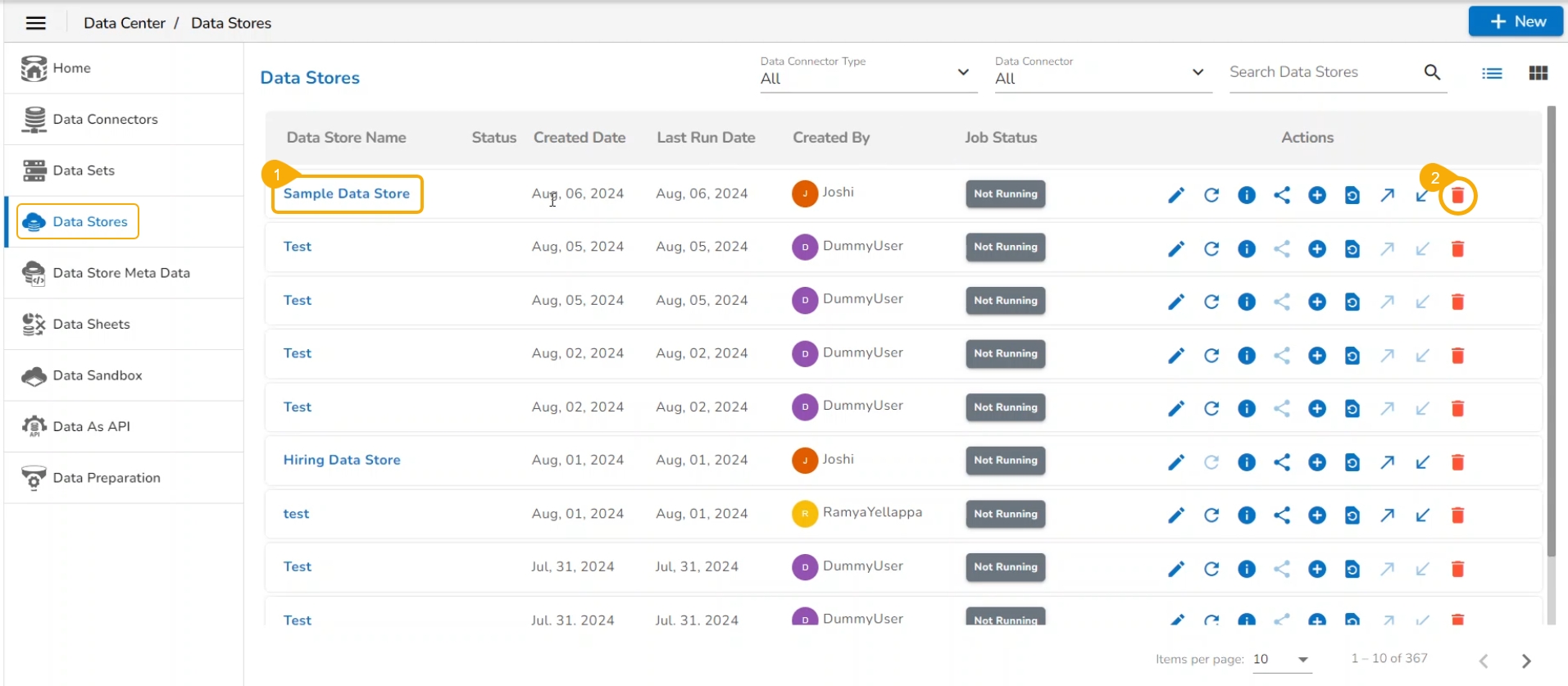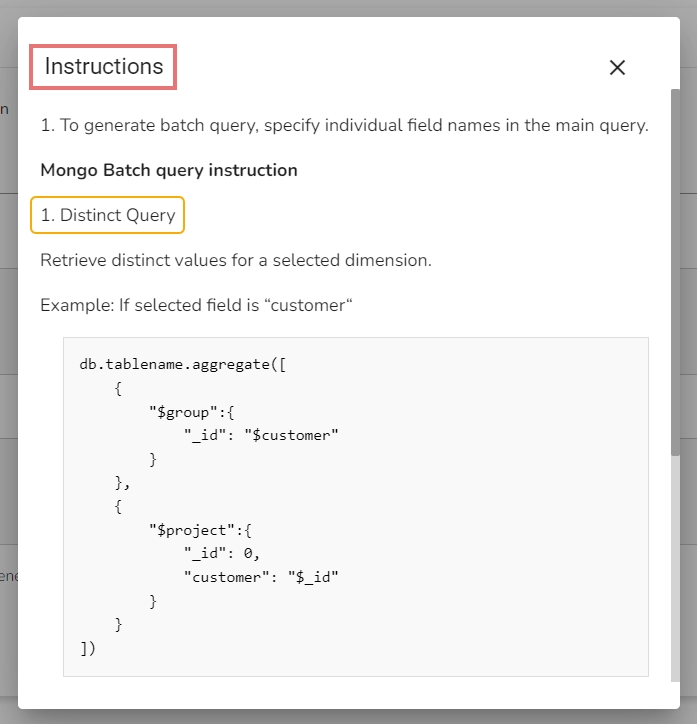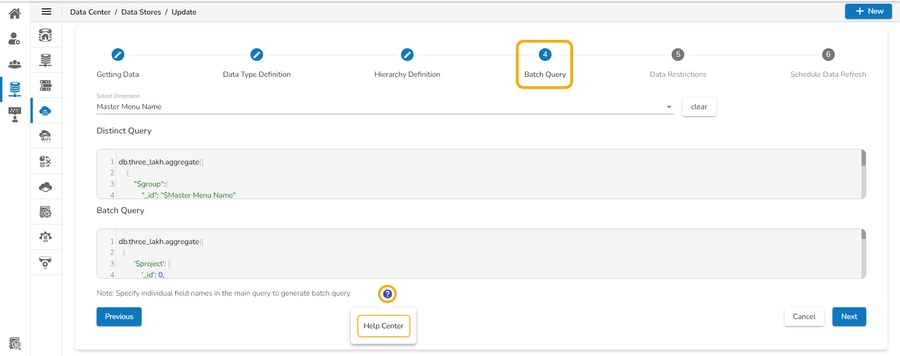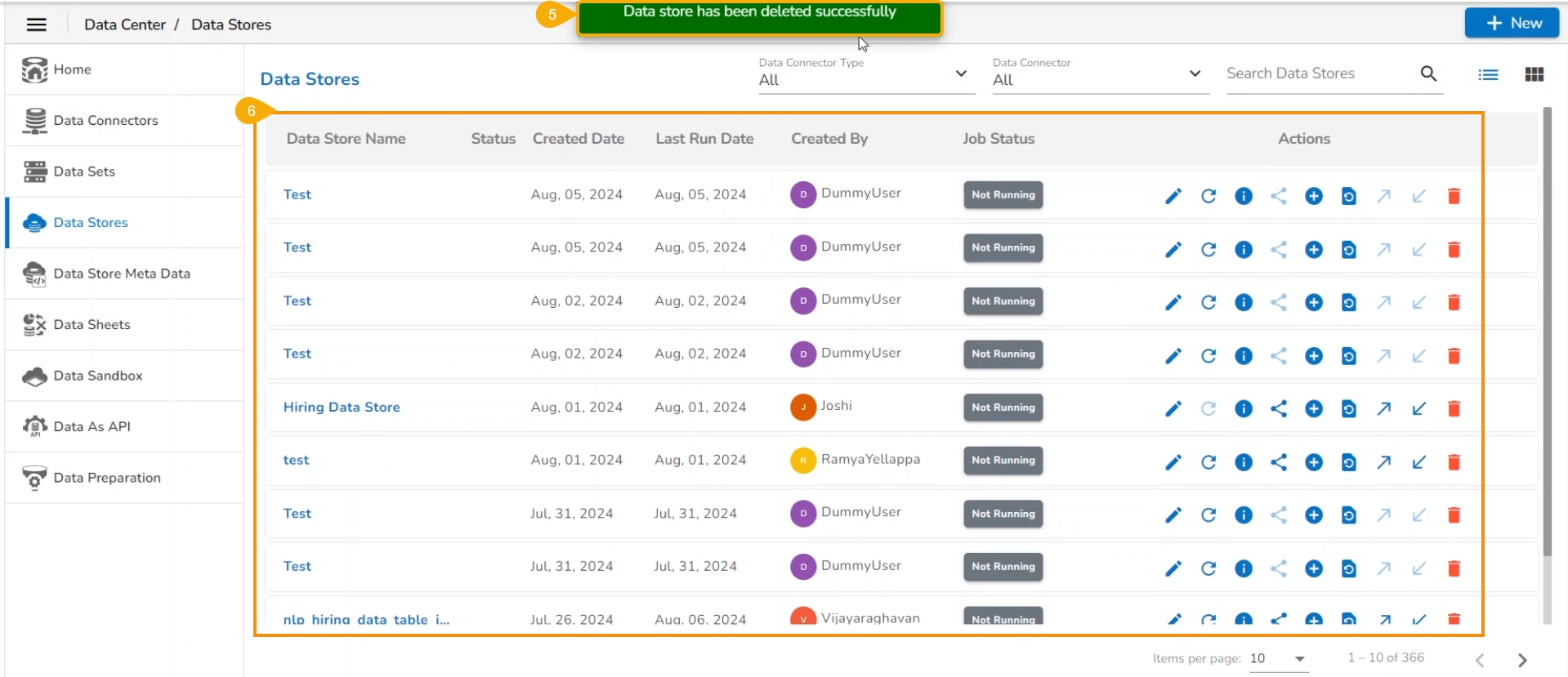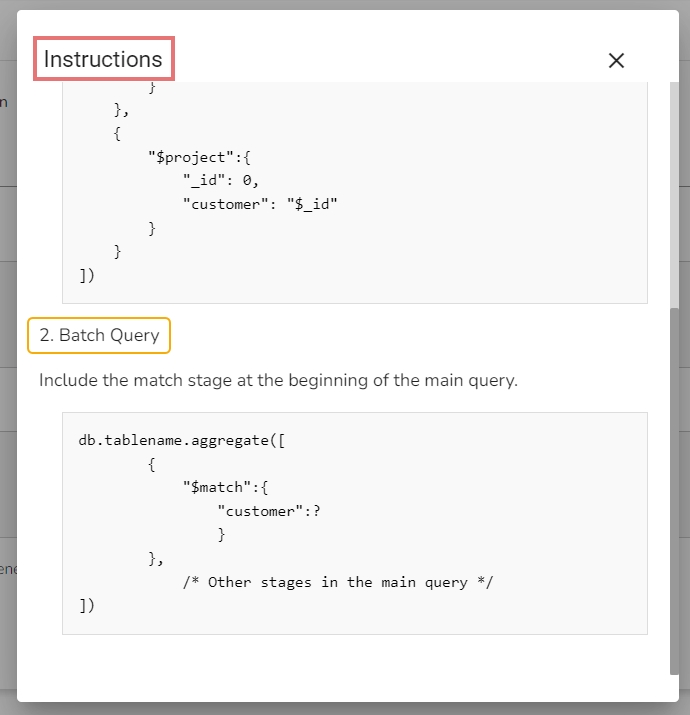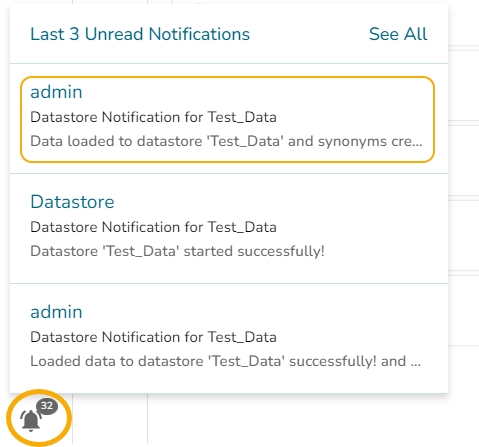Loading...
Loading...
Loading...
Loading...
Loading...
Loading...
Loading...
Loading...
Loading...
Loading...
Loading...
Loading...
Loading...
Loading...
This page aims to describe the various options provided on the Data Stores List.
BDB Data Store is a data source for persistently storing collections of data which include repositories like databases, APIs, and Flat files.
The user can create Data Stores based on various available Data Connectors from the Data Connectors list page or the Data Source page.
Navigate to the Data Center homepage.
Click the New option to open the context menu.
Select the Data Store option from the New Context menu.
The user gets redirected to the Data Source page.
Use the Search bar to search for a data source.
Select a Data Source from the list.
Click the Create Data Store icon for the selected Data source.
The user can enable the scheduler by using the given checkbox, in this case, the Create page of a Data Store will display 6 steps to follow to complete a Data Store creation.
The user gets redirected to the Create Data Store page including the following steps:
Getting Data
Data Type Definition
Hierarchy Definition
Batch Query
Data Restrictions
Schedule Data Refresh
The Create page for a new Data Store may display 5 stages to create a new Data Store if the Scheduler is not enabled.
The user can create a Data Store based on various data connectors using the Data Center module of the Platform. The major categories of the Data Store creation available on the platform are as follows:
Data Store using an RDBMS Data Connector
Data Store using an API Data Connector
Please Note:
The Schedule Data Refresh step will appear only if the Enable Scheduler option is enabled from the Getting Data step. This step will not be displayed for the Data Stores based on Flat File data connectors or the Data Stores based on the uploaded CSV/Excel file.
The user can also see the Data Stores created by Uploading a CSV/ Excel file for Creating a New Report getting listed on the Data Store List page.
The Data Stores created by the uploaded files will not support View/Edit, Refresh Data, Latest Schedule Status, Share Data Store, Push to VCS, Pull from VCS, and Visualize actions. Thus, all the above-stated options will be disabled for such Data Stores.
However, the user can Add Synonyms to Data Stores created by uploading CSV/Excel files and Delete them using the Data Store List.
Navigate to the Data Stores list page.
Select a Data Store from the Data stores list.
Click the View/Edit icon for that Data Store.
The selected Data Store opens in the editable format.
You can edit the permitted information from the Data Store form.
Select the Next option.
The user can edit the required details under the various steps of the Data Store till the last step gets configured.
Click the Finish option.
Please Note:
The steps required to create/edit a Data Store may vary based on the categories of the Data Source used.
The Finish option is provided on the last tab of the Data Store creation.
A confirmation message appears, and the selected Data Store gets updated.
Please Note: For the Database category of the Data Stores the user needs to Validate the information before saving it.
This page displays step-by-step process on how to create an API Data Connector based Data Store.
Check out the given walk-through on how to create a Data Store based on an API Data Connector.
Access the Data Source List page (Click the Data Store option from the New context menu, to access the Data Source List page).
Choose an API connector type from the filter panel.
Click on the Create Data Store icon to create the Data Store.
The Getting Data tab opens.
Provide a name for the Data Store.
The name of the selected Data Connector gets displayed by default.
Select a data set using the Data Set List drop-down menu.
Use a checkmark in the given box to Enable Scheduler
Click the Next option.
The Data Type Definition tab opens.
The user can interchange the available Dimensions, Measures, and Time fields to define data.
Enable dimension fields with a checkmark to get in the LOV of the Filter pane of the Self-service BI Report.
Click the Next option to proceed.
The Hierarchy Definition tab opens.
Add a new Drill Def box by clicking the Add icon.
Drag and drop Dimension or Time fields to create a hierarchy (The dragged and dropped Time fields get divided into three level granularities, E.g., Year>Month>Date).
Click the Next tab to proceed.
The Data Restrictions tab opens.
Click the Add icon.
Select a Dimension from the drop-down menu.
Enter a User Property based on the inserted custom fields of a specific user(s) or user group(s).
Click the Next option to proceed.
The Schedule Data Refresh tab opens.
The following options are provided to Schedule refresh the data:
Hourly
Daily (default option)
Weekly
Monthly
Yearly
Select any option from the above-given list and configure the required information to set the data refresh interval.
Select the Refresh Now option by enabling the box to refresh the Data Store immediately after creation.
Enable Email Notification by enabling the option.
Provide the Email Address to get notified by mail.
Click the Finish option.
A success message appears to inform about the creation of a new data store.
The newly created Data Store gets added to the Data Stores list.
This page helps to understand the Data Store creation flow with the RDBMS Data Connector.
Check out the illustration on the creation of Data Store.
The Getting Data tab opens by default while clicking the Create Data Store option.
Enter a name for the Data Store. The Data Connector and Database names are displayed based on the selection of the data connector.
Provide Description for the Data Store.
Write the SQL query in the given space (Use the Ctrl+ Space keys for assistance in writing a query.
Put a checkmark in the given box to use the Enable Scheduler option.
Click the Next option to proceed.
Users can define the data type using the selected data store. They can interchange the Dimensions, Measures, and Time fields by selecting the respective icons provided for these fields.
Navigate to the Data Type Definition tab.
Define the required Dimensions, Measures, and Time by interchanging the categories.
Enable the Dimensions by using a checkmark to avail List of Values (LOV) lookup in the filter panel of the Report.
Click the Next option to proceed.
The user can change the categories of a dimension, measure, and time values by clicking the following options:
Icons
Name
Description
Move to Dimensions
Moves the selected ?Measure or Time element to Dimension category.
Move to Measures
Moves the selected Dimension or Time element to Measure category.
Move to Time
Moves the selected Dimension or Measure to Time category/
Please Note: Click the Previous option to access the previous tab.
Define the hierarchy using various dimensions and time options.
Navigate to the Hierarchy Definition tab.
Click the Add option provided on the Hierarchy Definition page.
A new Drill Def box gets added.
Drag and drop the dimensions or time options to define a hierarchy.
The Time fields get separated in the 3-level granularity by dragging one time. By default, the Time dimensions can be split into Year>Month>Date hierarchy.
The Dimension fields must be dragged separately each time to create the hierarchy in the Drill Def box.
Click the Next tab to proceed.
Please Note:
Click the Previous option to go back to the previous tab.
Click the Remove option (in the Drill Def box) to remove the defined hierarchy using the selected option.
Split the data fetching process into different batches by generating a batch query.
Navigate to the Batch Query tab.
Select a Dimension using the drop-down menu.
Click the Generate option.
Based on the selected dimension, a distinct query gets generated (in the below-given box). The user can edit the distinct query as per their requirement.
Click the Generate option provided for the Batch Query option.
The original query generates the distinct query specifications to fetch data.
Proceed to the next tab by clicking the Next tab.
Please Note:
The Batch Query does not get generated automatically for the Data stores based on the MongoDB, the users need to write the batch query in the given Batch Query space. The sample Distinct Query and Batch Query examples are provided below.
The Batch Query page contains a Help Center option to get Instructions on how to write a Batch Query for the MongoDB.
Configure the Data Restrictions settings to restrict a user-level view of the data store.
Navigate to the Data Restriction tab.
Click the Add icon to add a new box for inserting the data restriction parameter.
Select a dimension from the drop-down menu.
Enter the user/group-specific custom field to restrict the data.
Click the Next option to proceed.
Please Note: The Administrator can restrict data access for specific users by configuring the User Property via the Data Restriction tab. For instance, if a custom field 'Country' is set to 'India' for a user or user group, and the administrator uses this field while creating a data store, only those users can access data related to India.
The user can schedule a data refresh interval via the Schedule Data Refresh tab.
Navigate to the Schedule Data Refresh tab. (This tab only appears for the Data Stores where the scheduler has been enabled using the Getting Data tab).
Define a time range to refresh data using the following options:
Hourly
Daily (default option)
Weekly
Monthly
Yearly
(Select any one option from the above-given list to set the data refresh interval)
Enable the Refresh Now option by using a checkmark in the given box.
Enable the Email Notification option by providing a checkmark in the box.
Provide a valid email address to receive the notification email regarding the Data Store.
Click the Finish option to complete the Data Store creation process.
A message appears to confirm that the data store configuration has been saved.
The Data Stores List opens.
A new Data Store gets created and added to the displayed list.
Icon
Name
Task
View/Edit
Opens the Data Store in editable format the datastore fields.
Refresh Data
Refreshes data for a datastore.
Latest Scheduled Status
Displays the latest scheduler status via a pop-up window.
Share Data
Shares a datastore to/for the selected user(s) or group(s).
Add Synonyms to Data Store
Adds more synonyms to a Data Store.
Refresh Synonyms
Refreshes Synonyms for the selected Data Store.
Push to VCS
Pushes the Data Store to the GIT repository.
Pull From VCS
Pulls the Data Store to the GIT repository.
Delete
Deletes the selected Data Store.
Visualize
Redirects the user to Widget Visualizer page.
Select a Data Store from the Data Stores list.
Click the Refresh Data icon for that Data Store.
The Data Store Refresh dialog box opens.
Click the Yes option.
A notification message appears stating that the Refresh process has been started and status notification will be provided to the user through the notification icon.
Please Note: The Notification icon will get a new notification when the Data Store data gets loaded.
This page focuses on the Push to VCS functionality for Data Stores.
This is the mechanism for versioning the Data Store and storing the latest versions in Git. While pulling the Data Store, the user can see each version's committed message. The user will get more info about the committed data set.
Check out the illustration to push a version of a Data Store.
Select a Data Store from the Data Stores list.
Click on the Push to VCS icon.
The Push into Version Controlling System dialog box appears.
Commit message – this message is saved as a label in GIT.
Click the Push option.
A confirmation message appears and the Data Store version gets pushed to the VCS.
Please Note: Commit message is a required field after giving the message only the Push option will get enabled.
Check out the illustration on adding synonyms to a Datastore.
Select a Data Store from the Data Stores list.
Click the Add Synonym to Data Store option.
All the Attributes are displayed in a list form.
You can search for a field from the displayed list using the Search space.
Select a field name.
Click the Add Synonyms option.
A new window opens to add synonyms.
Insert new synonyms in the specified space.
The added synonym(s) appear below with the remove option.
Click the Save option.
A success message appears to ensure that the synonym dictionary is updated with the newly added synonym.
Check out the video on adding synonyms for a Dimension Value.
Select a Data Store from the Data Store List.
Click the Add Synonym to Data Store icon.
The NLP Synonyms window opens for a data store.
You can search for a Dimension from the displayed list using the Search space.
Select a Dimension.
Select the Add Values option for the selected Dimension.
The selected Dimension appears on the top. (E.g., skills in the below image).
Use the search bar to find specific dimension values.
A list of Values appears.
Select a Value from the displayed list.
Click the Add Synonyms option for the selected value.
The selected dimension value appears to add synonyms.
Add synonyms by inserting new synonyms in the specific space, and clicking the Enter key.
The Value gets added to the selected dimension value.
Click the Save option to save the added synonyms.
A success message appears to ensure that the Synonyms dictionary is updated.
Check out the illustration on providing the Units for Measure values.
Select a Data Store from the Data Store list.
Click the Add Synonyms to Data Store icon.
The NLP Synonyms window opens for a data store.
You can search for a Measure from the displayed list using the Search space.
Select a Measure from the displayed list.
Click the Units drop-down menu to display the options of the unit.
Select a unit for the Measure.
A notification message appears to inform the recent update the user, and the user gets redirected to the Data Stores List page.
This option provides the Data Store details for the selected Data Store.
Select a Data Store from the Data stores list.
Click the Store Info icon for that Data Store.
The Data Store Info drawer opens displaying the following details:
Datastore Name: Name of the Datastore.
Data Loaded From: Source database from where the data is loaded.
Total Records: Total no. of records.
Last Refreshed: Date when the Data Store was last refreshed.
Default Synonyms: Enabling this option allows recreation of the synonyms.
Global Search: Enabling this option allows the user to access the concerned Data Store while using the Global Search.
Status: It indicates the status of the job that runs while refreshing the Data Store data.
The Refresh Synonyms option helps to refresh data store tables to reflect the later changes in the data store synonyms directory.
Navigate to the Data Stores list.
Select a Data Store from the list.
Click the Refresh Synonyms icon.
A confirmation message appears to inform the users that the Synonyms are updated.
This option helps the user to share a Data Store with other user(s) or user group(s). The user can also exclude a user(s) or user group(s) from the rights to access a Data Store using the Exclude User option provided under the Share Data Store dialog box.
Check out the illustration on the Share Data Store functionality.
Select a Data Store from the Data Stores list.
Click the Share Datastore icon for the selected Data Store.
The Manage Access window opens.
Select permission using the Grant Permissions section.
The Users, User Groups, and Exclude Users tabs appear.
Search a specific user or user group using the search bar.
Select user(s) or user group(s) using the Users or User Groups tabs.
Click the Save option.
A confirmation message ensures that the selected Data Store is shared successfully.
The selected user(s)/ user group(s) will be listed under the Granted Permissions.
Navigate to the user account where the Data Store is shared.
The shared Data Store lists the Status mentioned with a Share icon for the user(s) to whom it has been shared. The Actions may vary based on the selected granted permission for the Data Store.
The shared Data Store will have limited Action permissions.
Please Note: A targeted share user cannot re-share or delete a shared Data Store, regardless of the permission level (View or Edit).
Check out the illustration on excluding user(s) while sharing a Data Store with the selected user group(s).
Navigate to the Manage Access window for a Data Store.
Select privileges using the checkboxes provided for the Grant Privileges.
Navigate to the User Groups tab.
Select user group(s) using the checkbox.
Navigate to the Exclude Users tab.
Select the users to be excluded from the selected group(s) to access the data store using the checkboxes.
Click the Save option.
A notification message appears, and the selected user group(s) name will be added under the Granted Permissions section.
The excluded users will be listed under the Excluded Users section.
Check out the illustration on including an excluded user.
Open the Manage Access window for a shared data Store.
Navigate to the Excluded Users list.
Select a user from the list.
Click the Include User icon.
A notification ensures that the privileges are shared with the recently included user from the group.
The Excluded Users list gets modified.
Check out the illustration on revoking a user's access to a shared Data Store.
Navigate to the Manage Access window.
The Granted Permissions will be listed.
Select a user or user group from the displayed list.
Click the Revoke Privileges icon.
A notification message appears, and the granted permissions list gets modified as the targeted user/ user group gets removed from the list.
Please Note:
Users can share the Data Store with a Single group or Multiple Groups using the user group tab. The steps to share a Data Store with User Group(s) are similar to those mentioned above for sharing a Data Store with User(s).
The Exclude User tab helps to exclude the user(s) from the rights to access a Data Store, if it is already shared. Only the users of the selected user group with whom it has been shared will be listed under the Exclude User tab.
This page describes the Pull from VCS functionality for Data Store.
Check out the illustration to understand the Pull from VCS functionality for a Data Store.
Select a Data Store from the Data Stores list (The Data Store should be Pushed at least once to the GIT repository).
Click the Pull from VCS icon for the selected Data Store.
The Pull from VCS dialog box appears.
The multiple uploaded versions of a Data Store with the committed message for each version are listed as shown below:
Select: To select the version you want to pull.
Version: Version number only will list as V1, V2, etc.
Commits: This is to Identify the Data Store version Pulling from VCS (This is the message given while committing the data store push).
Commit Time – The date and time that the Data Store is committed.
Committed By- The Username who committed the Data Store versioning.
Click the Pull option.
A confirmation message appears once the selected version of the Data Store is pulled from the VCS.
Please Note: Once the user selects any version, the Pull option gets enabled.
This page describes steps to delete a data store from the Data Store List.
Check out the illustration on deleting a Data Store.
Select a Data Store from the Data Stores list page.
Click the Delete icon for the selected Data Store.
The Remove Data Store dialog box opens to confirm the deletion.
Click the Yes option.
A confirmation message appears.
The selected Data Store gets removed from the Data Stores list.











